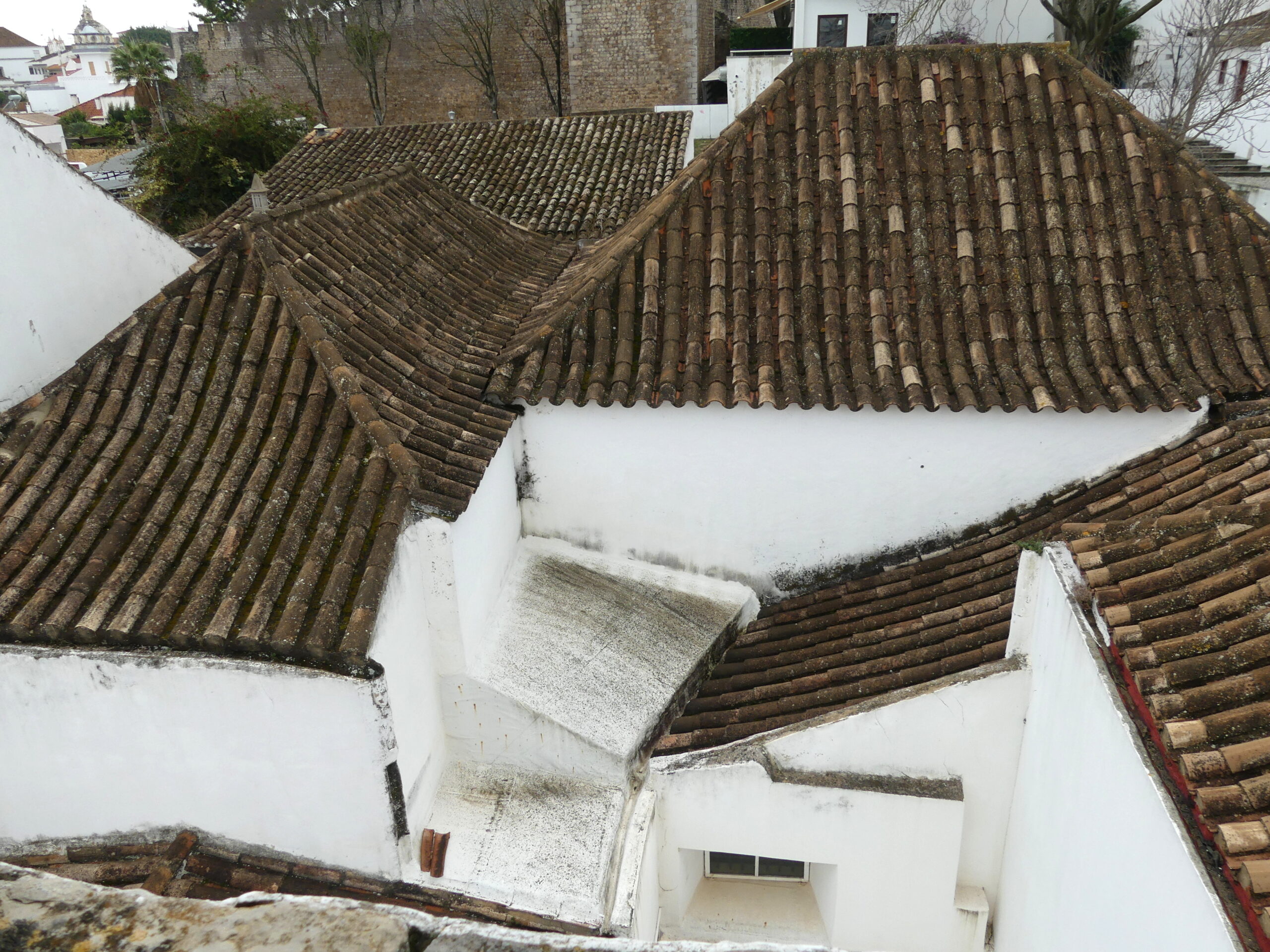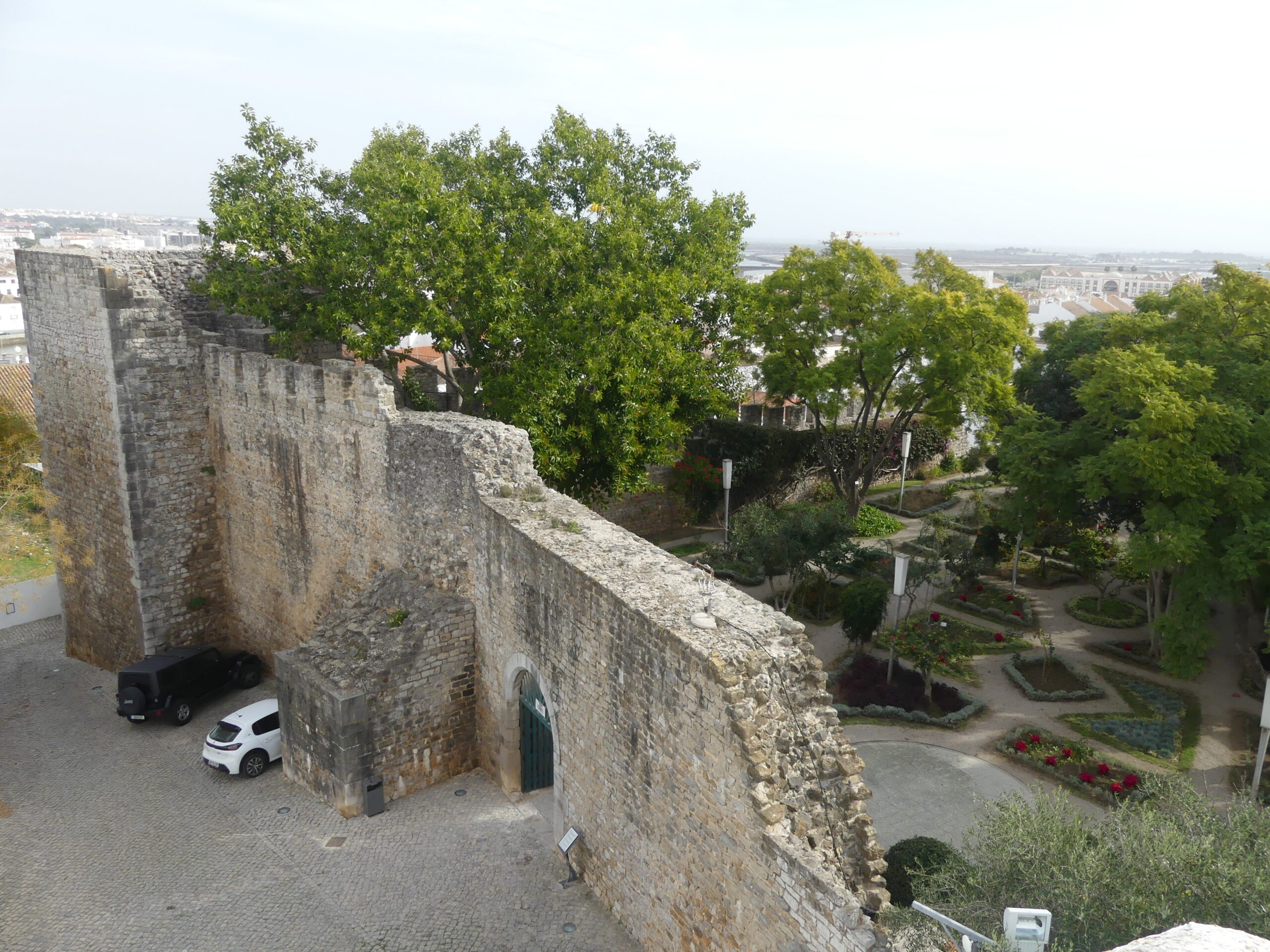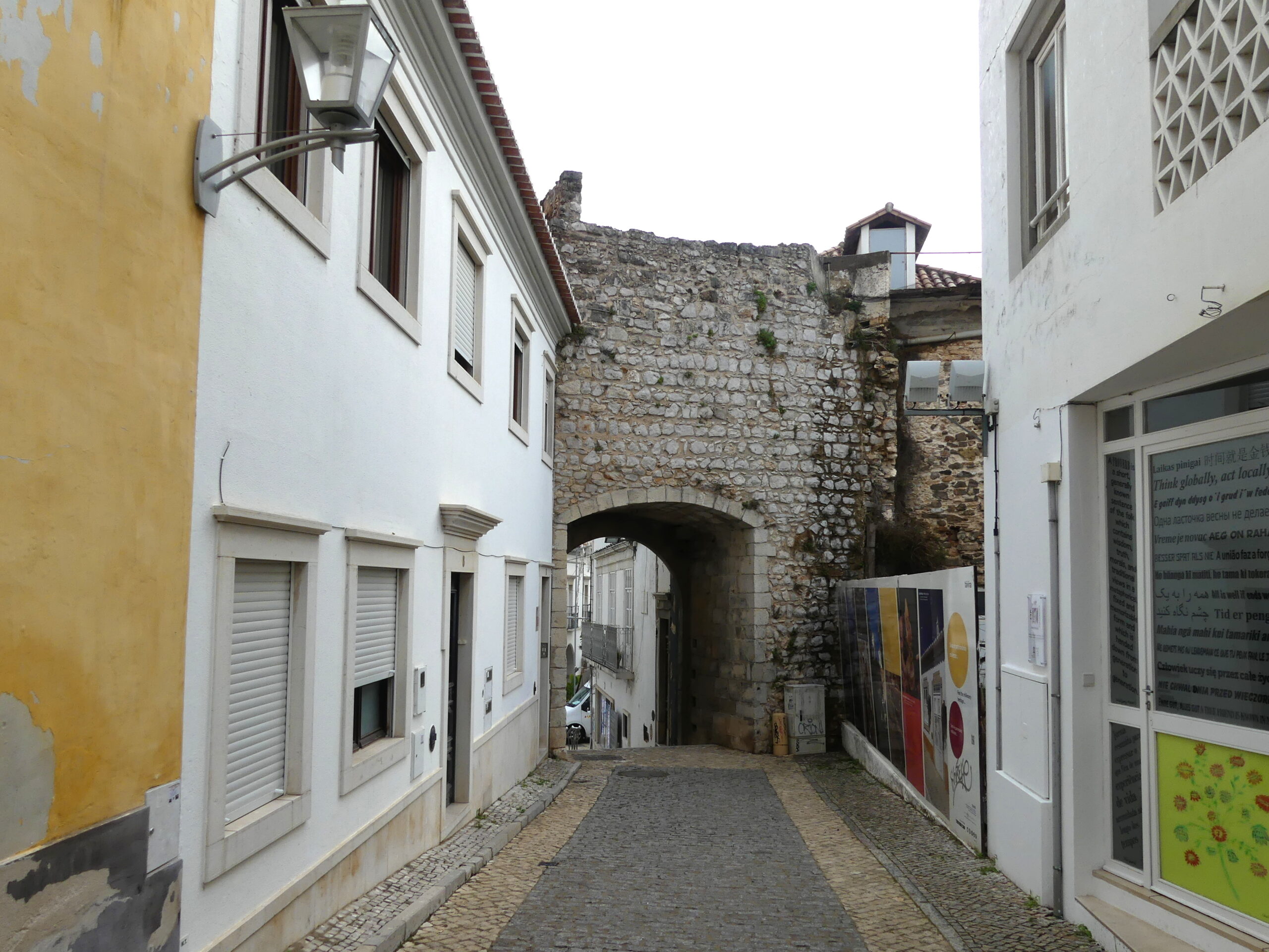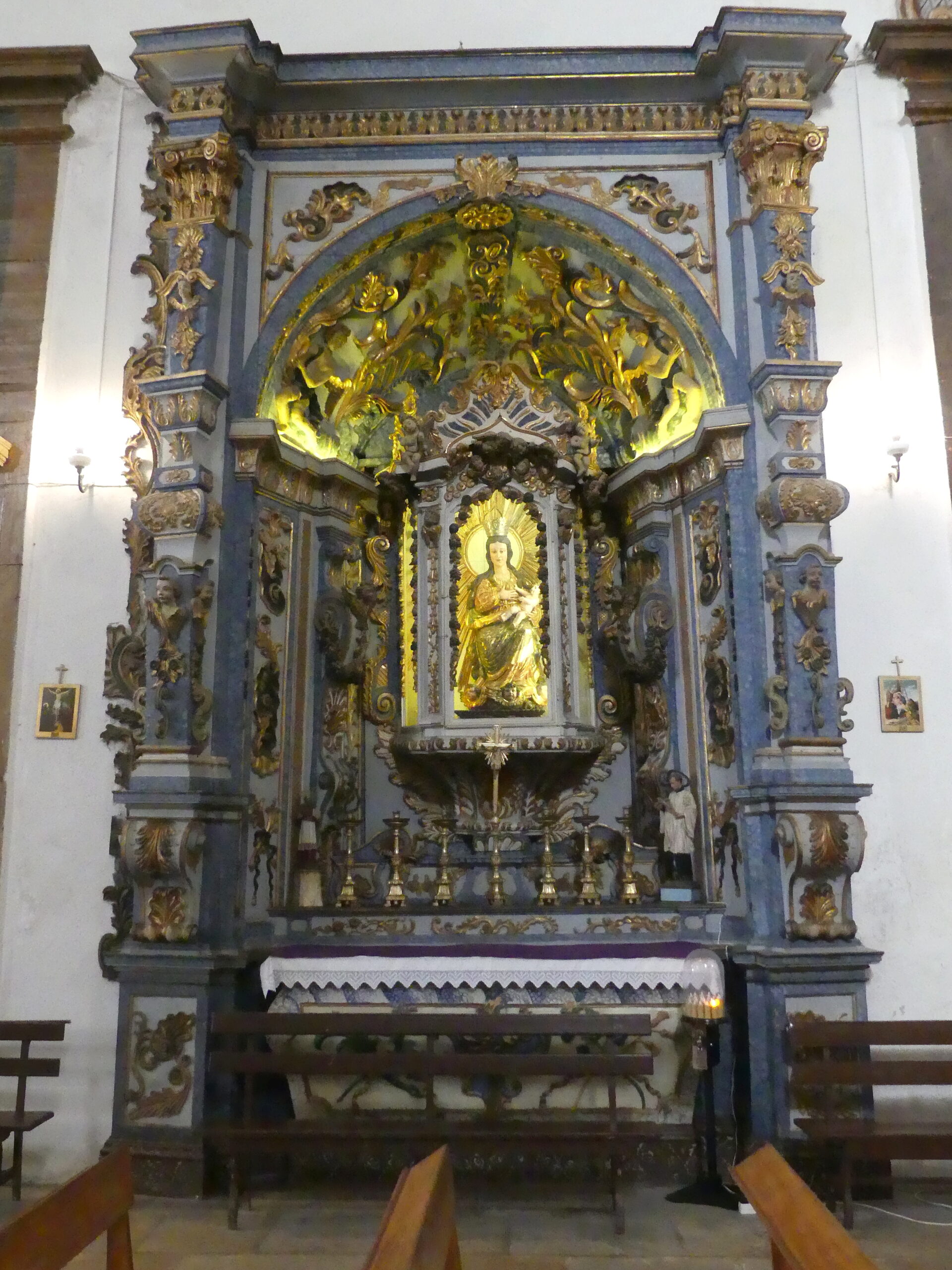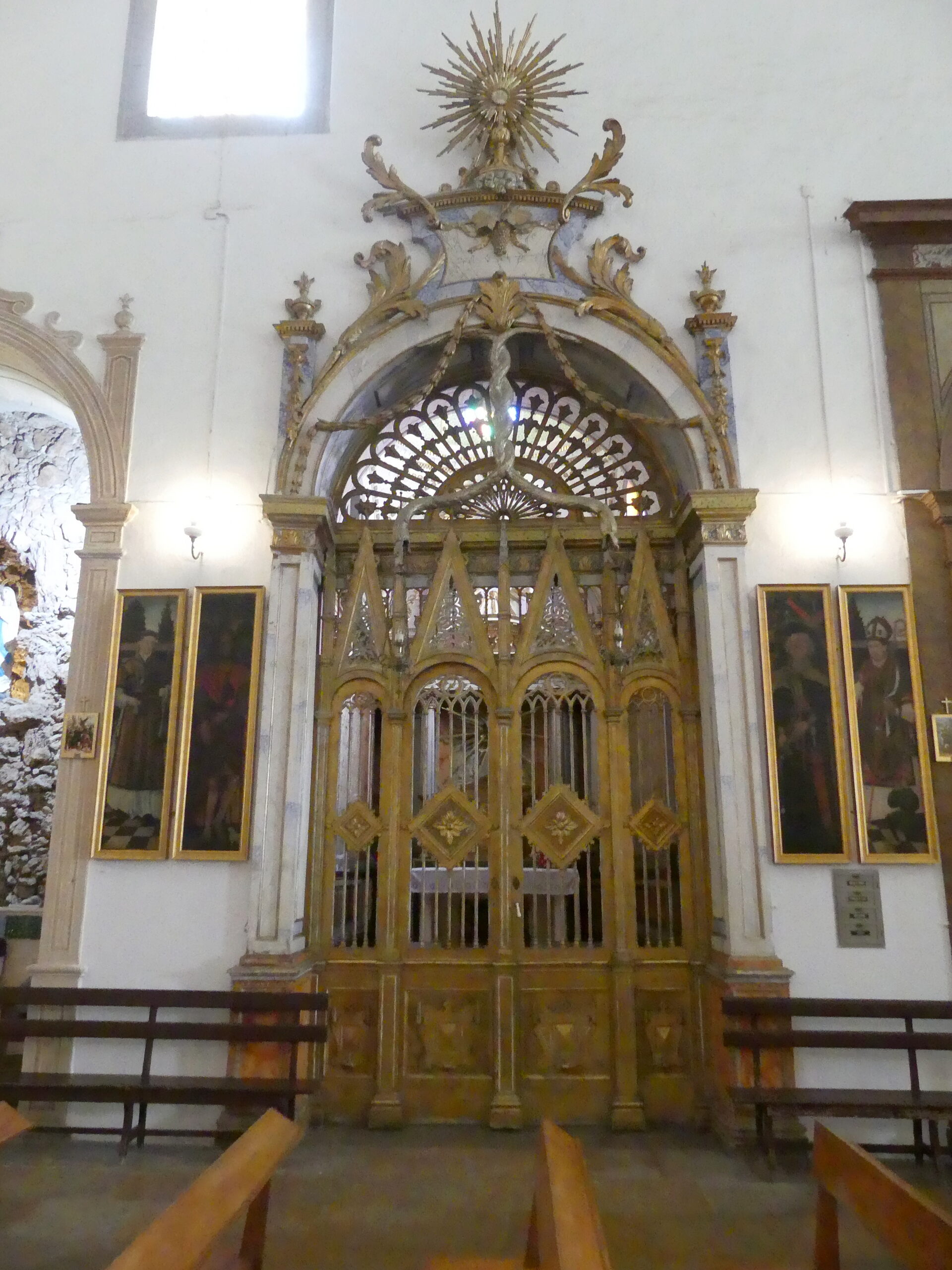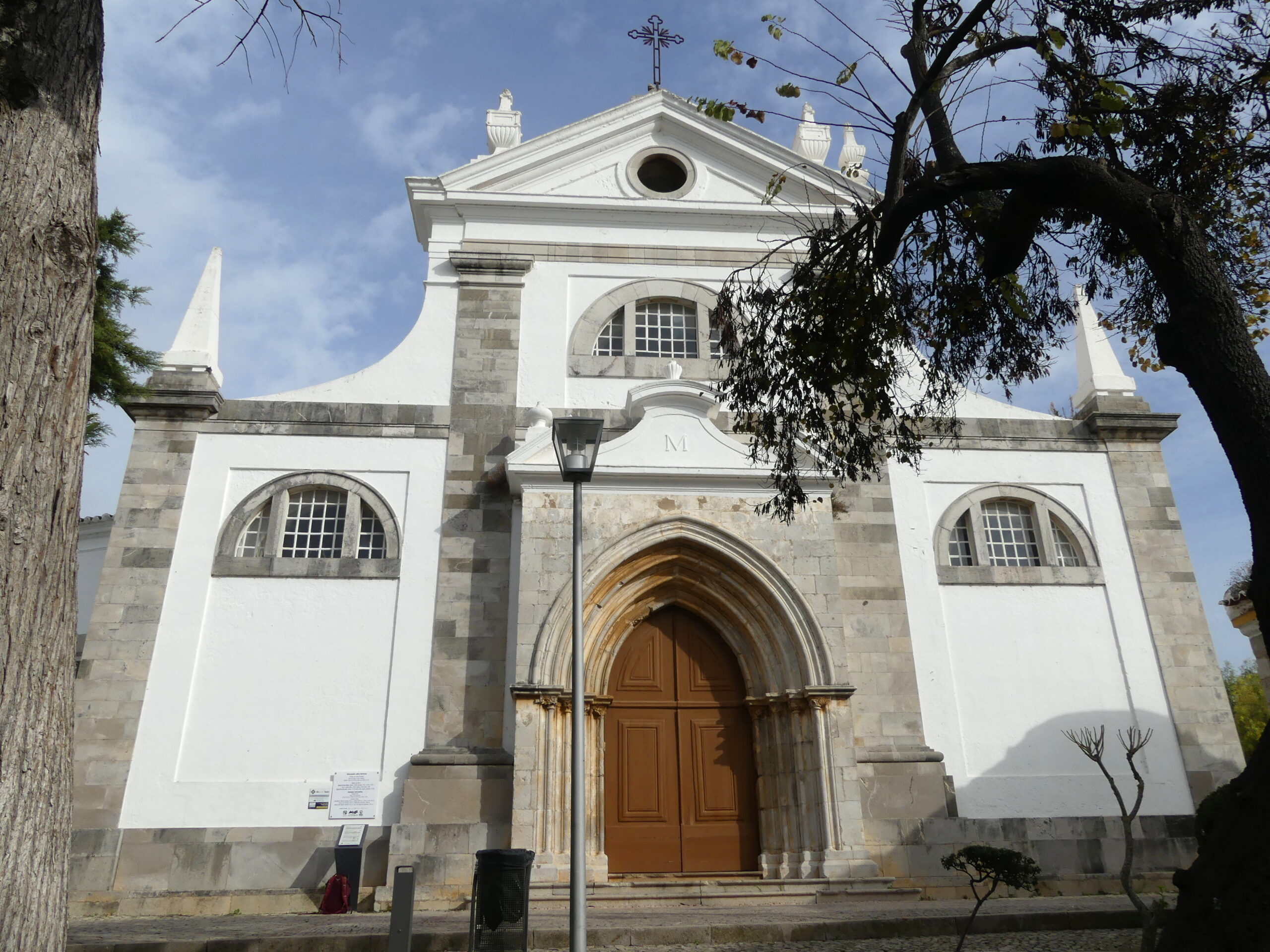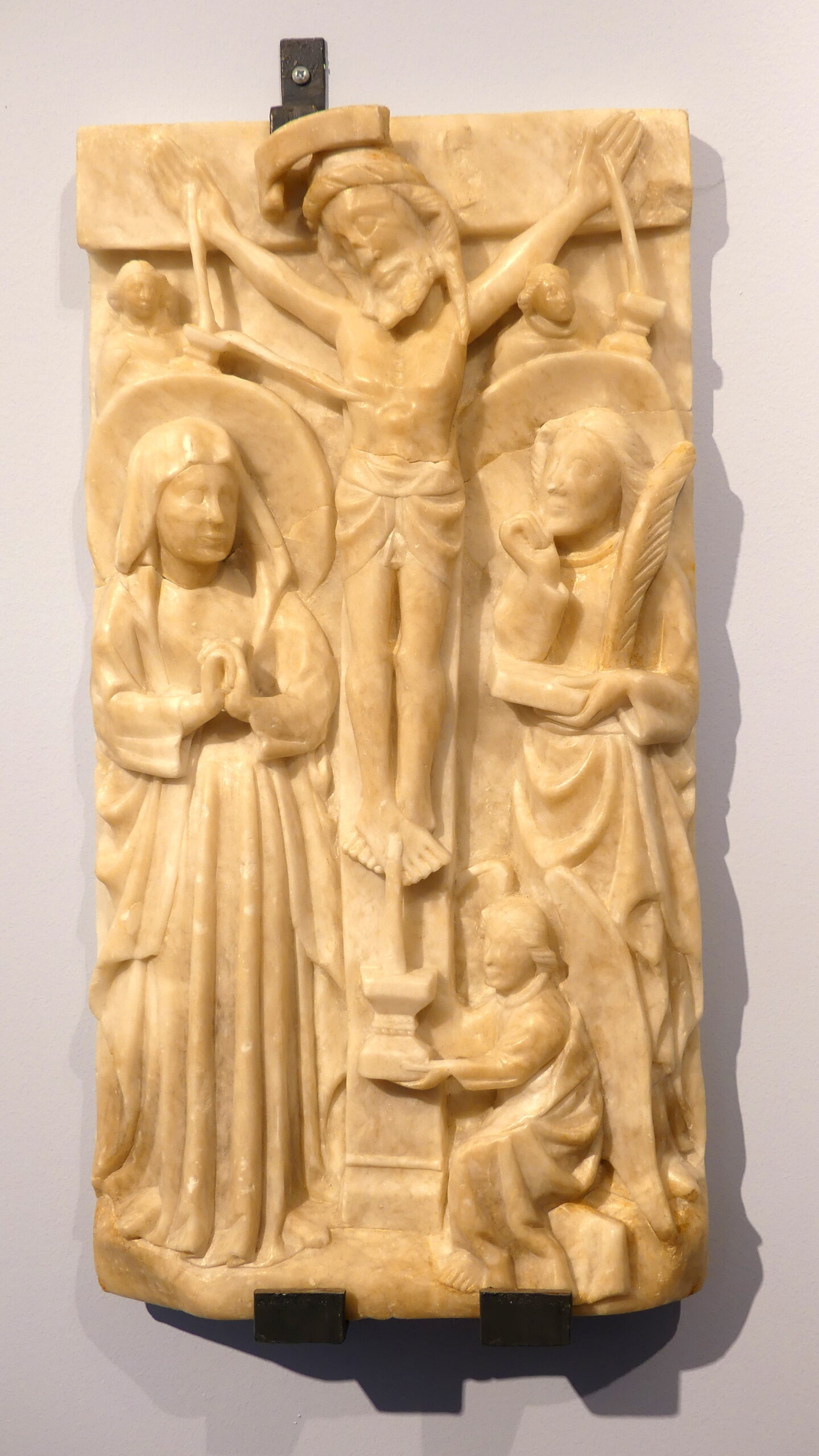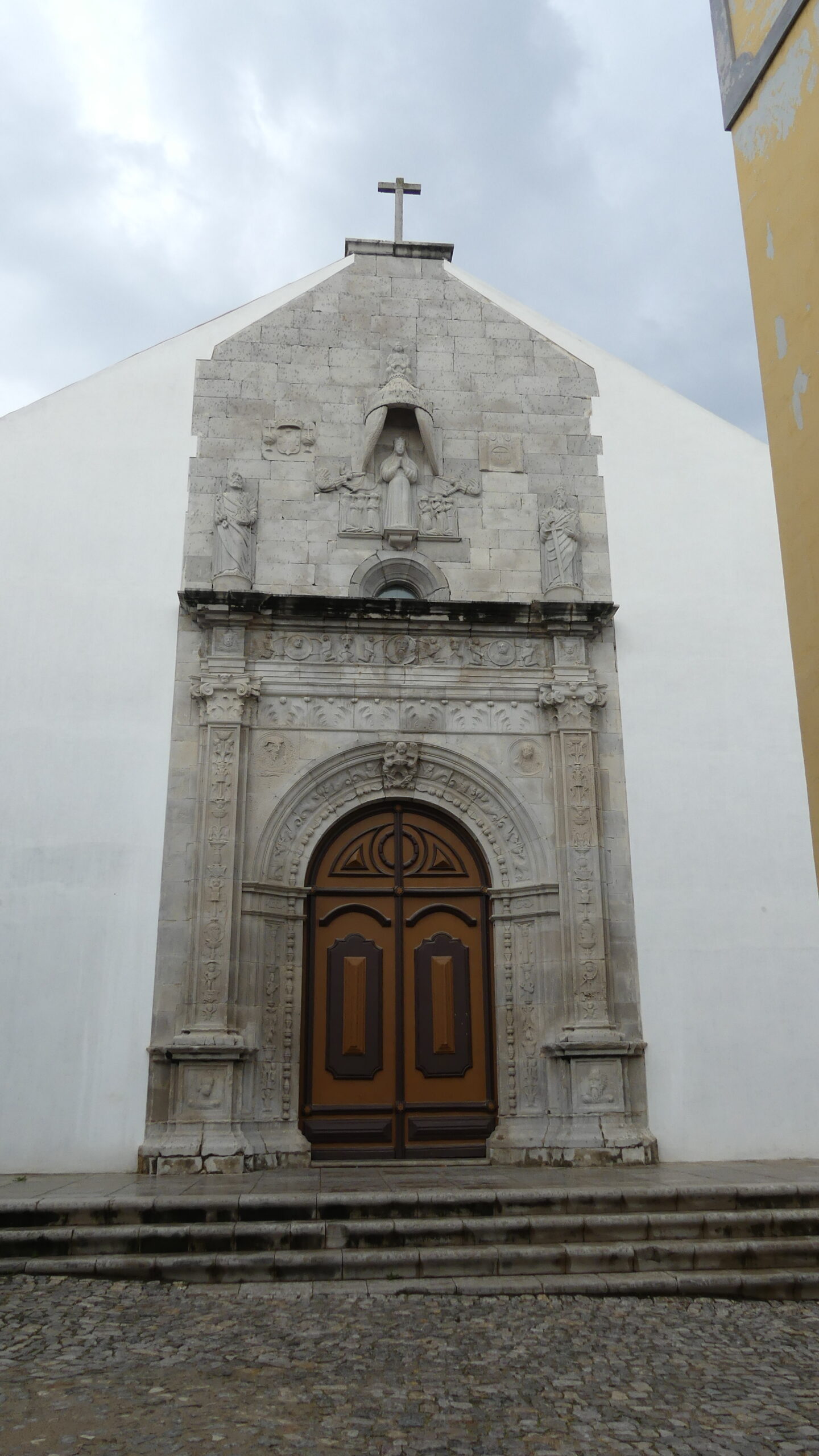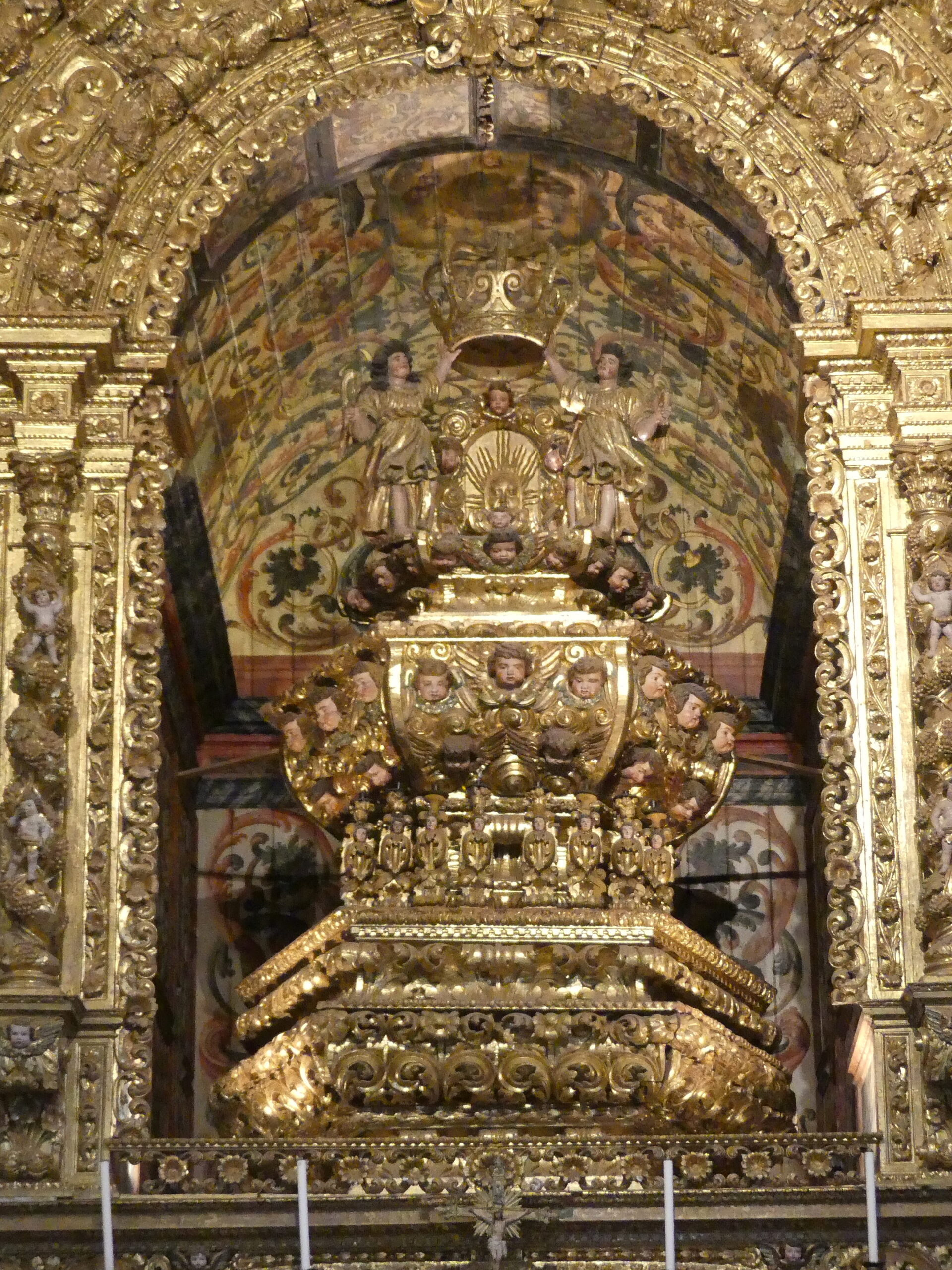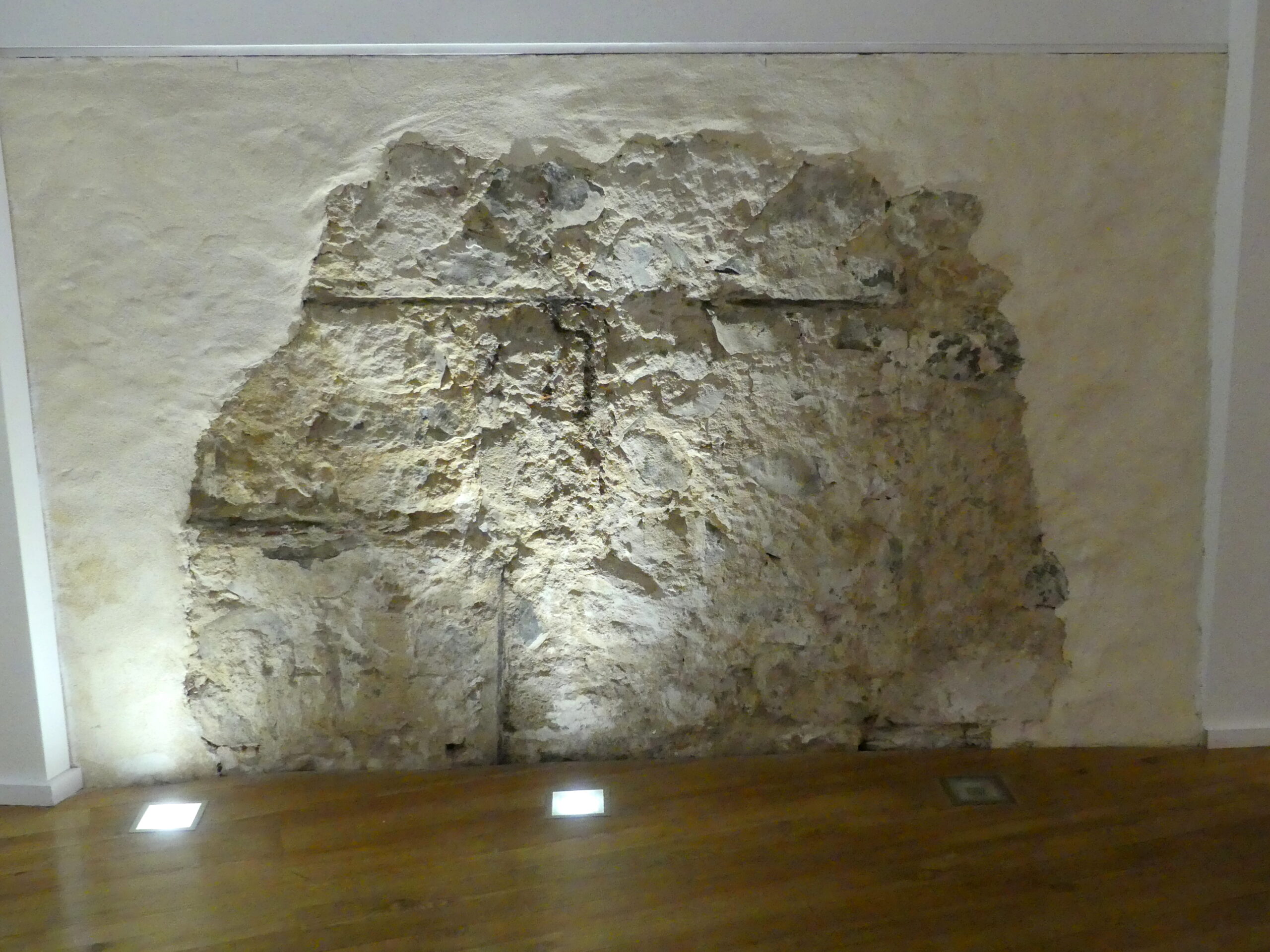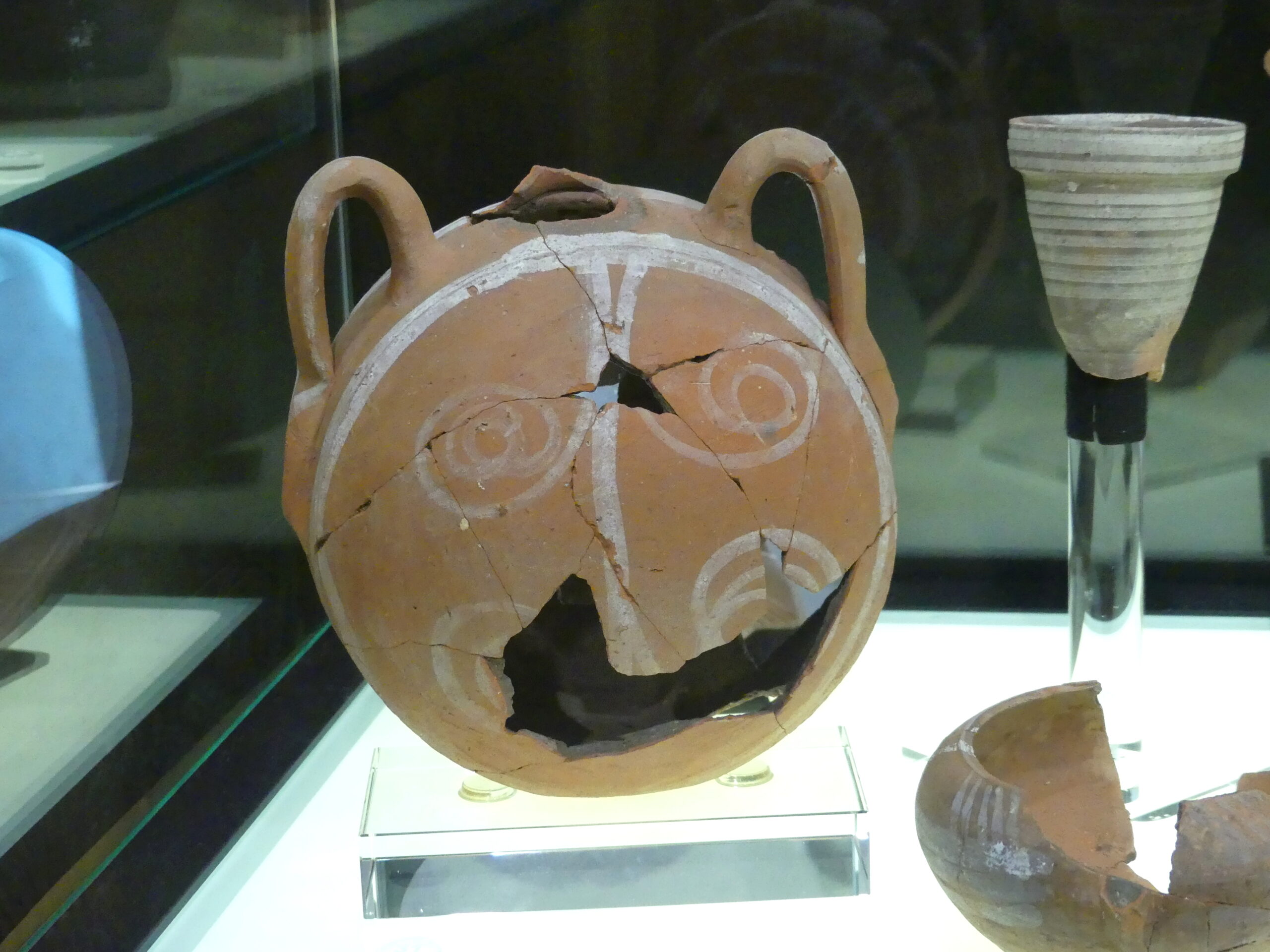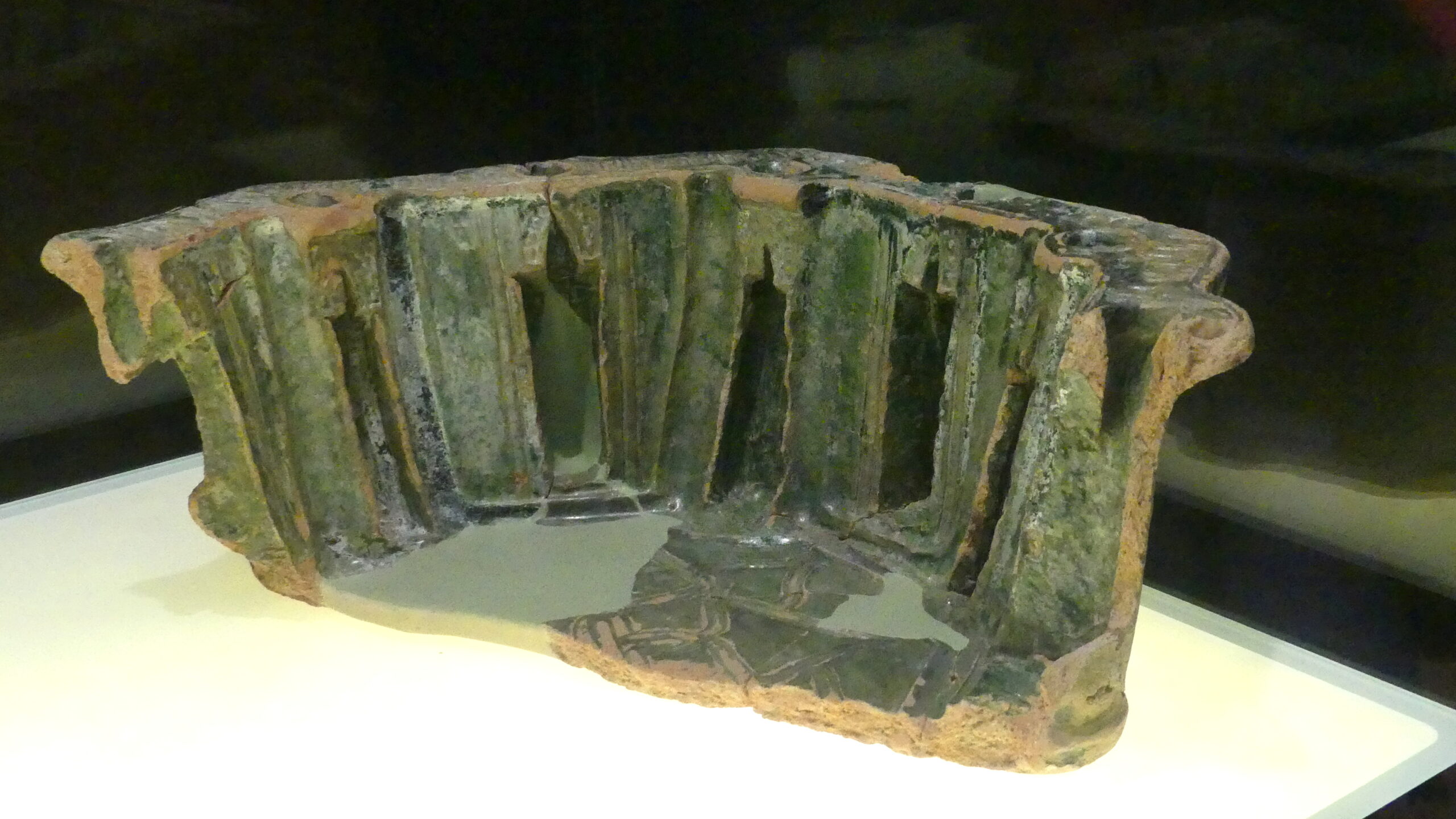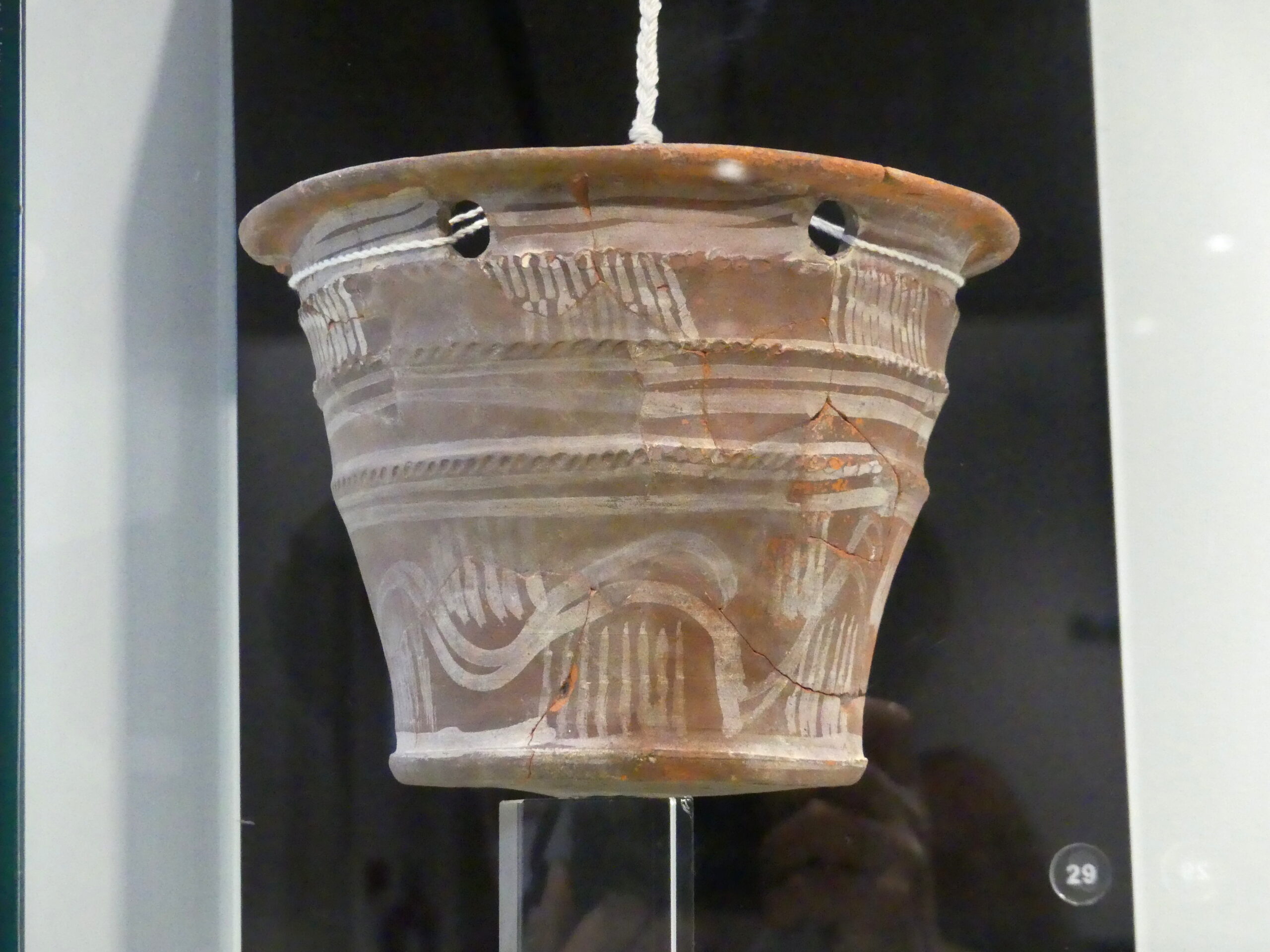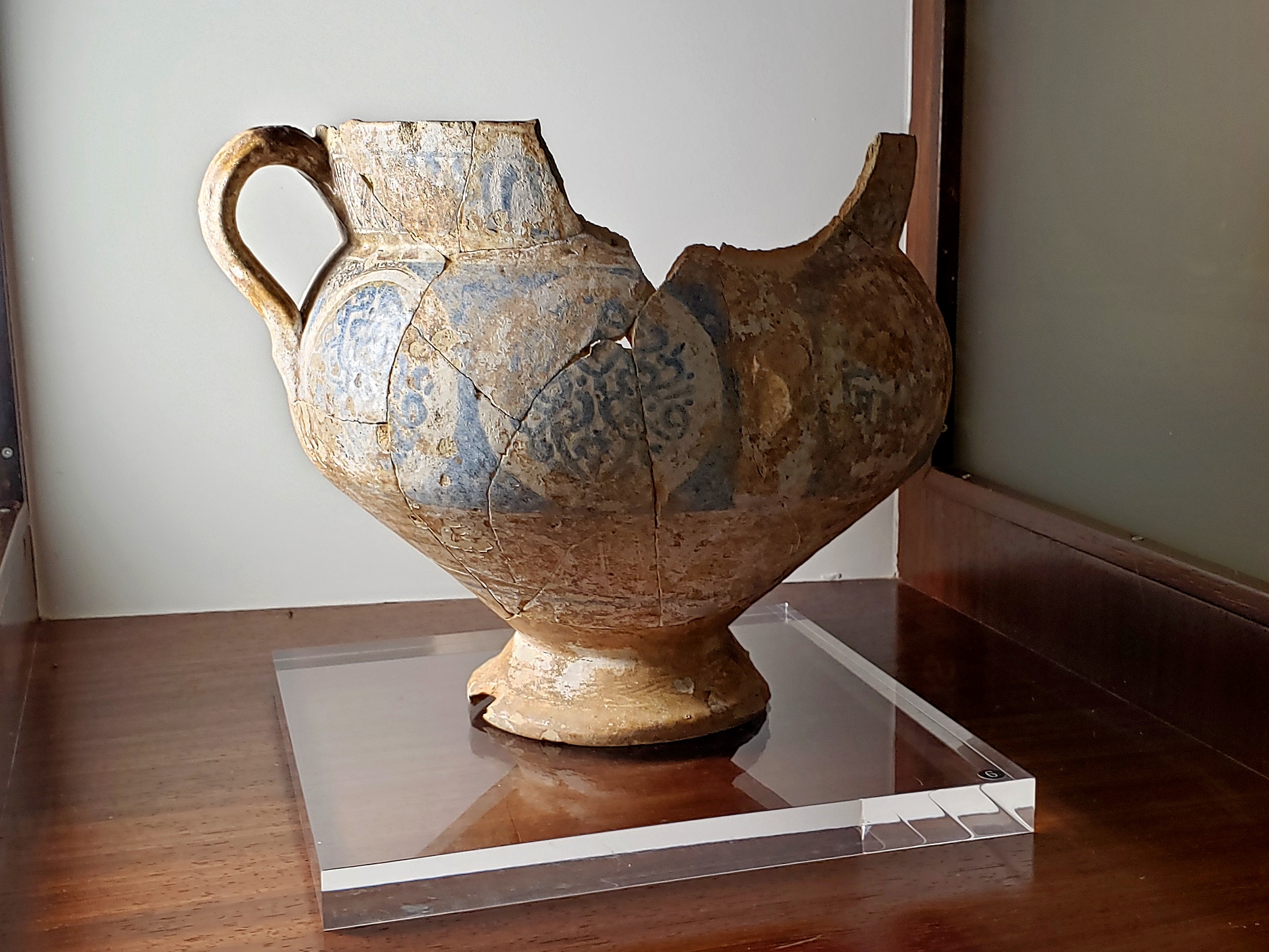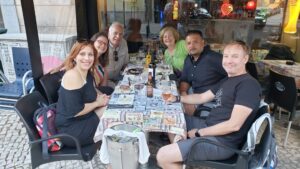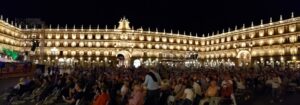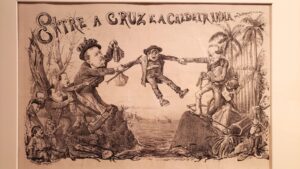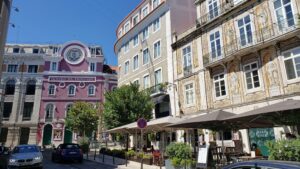In brief: What could there possibly be to do in an area known for its beaches during a cold wet December week? Quite a lot!
People who visit the eastern Algarve sort themselves out by which of the old fishing and mercantile towns they prefer. We thought the cityscape of Tavira, set on hills and its riverway, made it particularly engaging.
Tavira is not a big place, but it is rich in cultural heritage, as well as natural assets shared with other towns in the Algarve, the Portuguese Riviera.
During a Christmas week dominated by clouds and storms, we enjoyed pleasurable walks through the town and spent much time on those cultural resources, rather than the beaches, barrier islands, and typical pleasures of the summer season.
From castle hill through the old town
Atop the St. Mary church tower, we were happy to see the sun peek through while we gazed over the old castle and the just visible river below us (or between us in the photo).
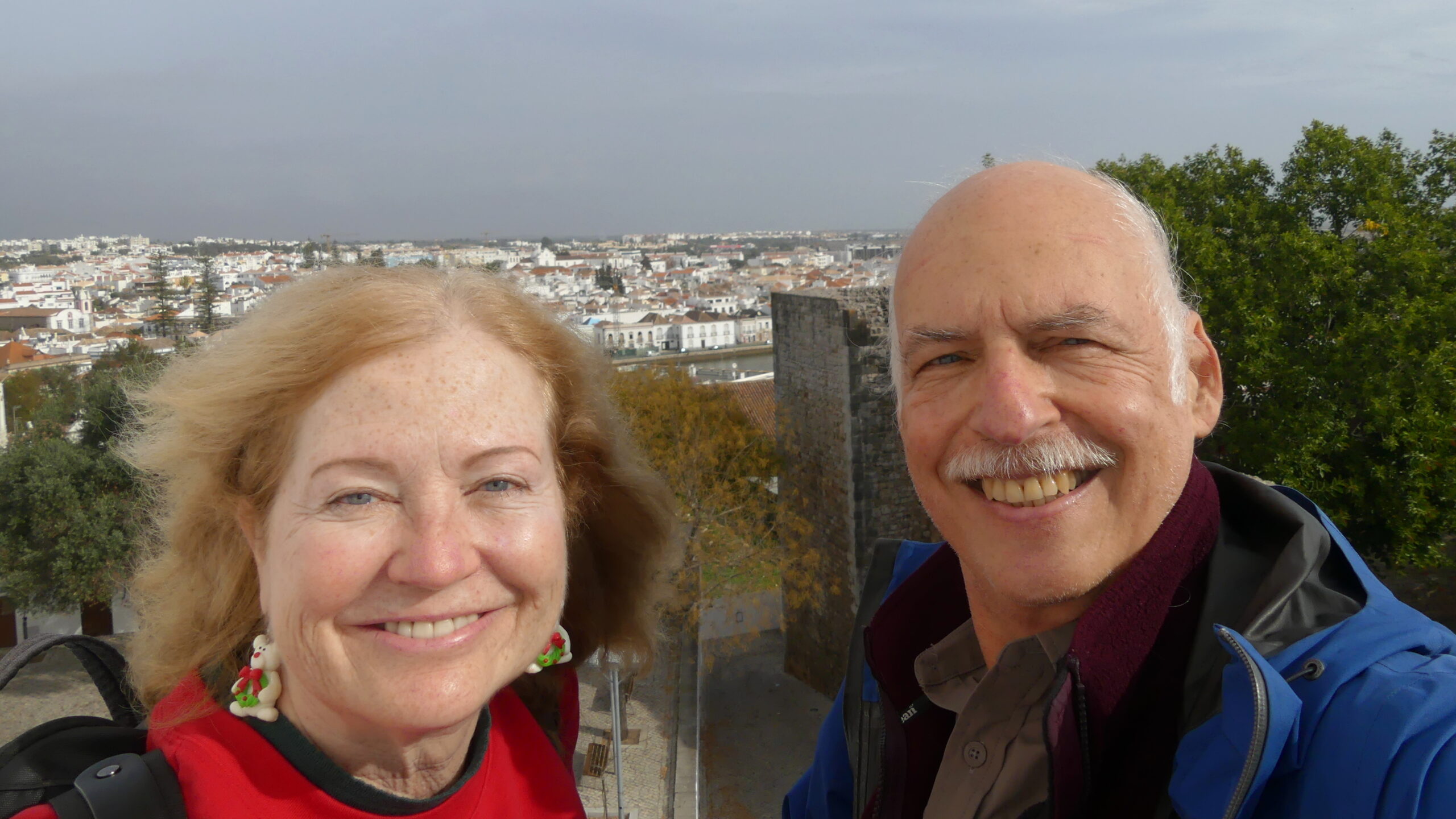
A bird’s eye view of older rooftops in Tavira, with a glimpse, toward the back, of white town buildings and a church, as well as the old castle walls.
The old medieval castle, once held by the Moors and then rebuilt over time by the Portuguese Christians.
On the highest hill of Tavira, it offers vantage points over the city when you scale its walls or turrets, but is now a garden with a wide variety of flowering plants and trees.
We had climbed the nearby bell tower of the St. Mary church for an even higher elevation.
The bell tower and imposing clock of St. Mary church seen from within the old castle.
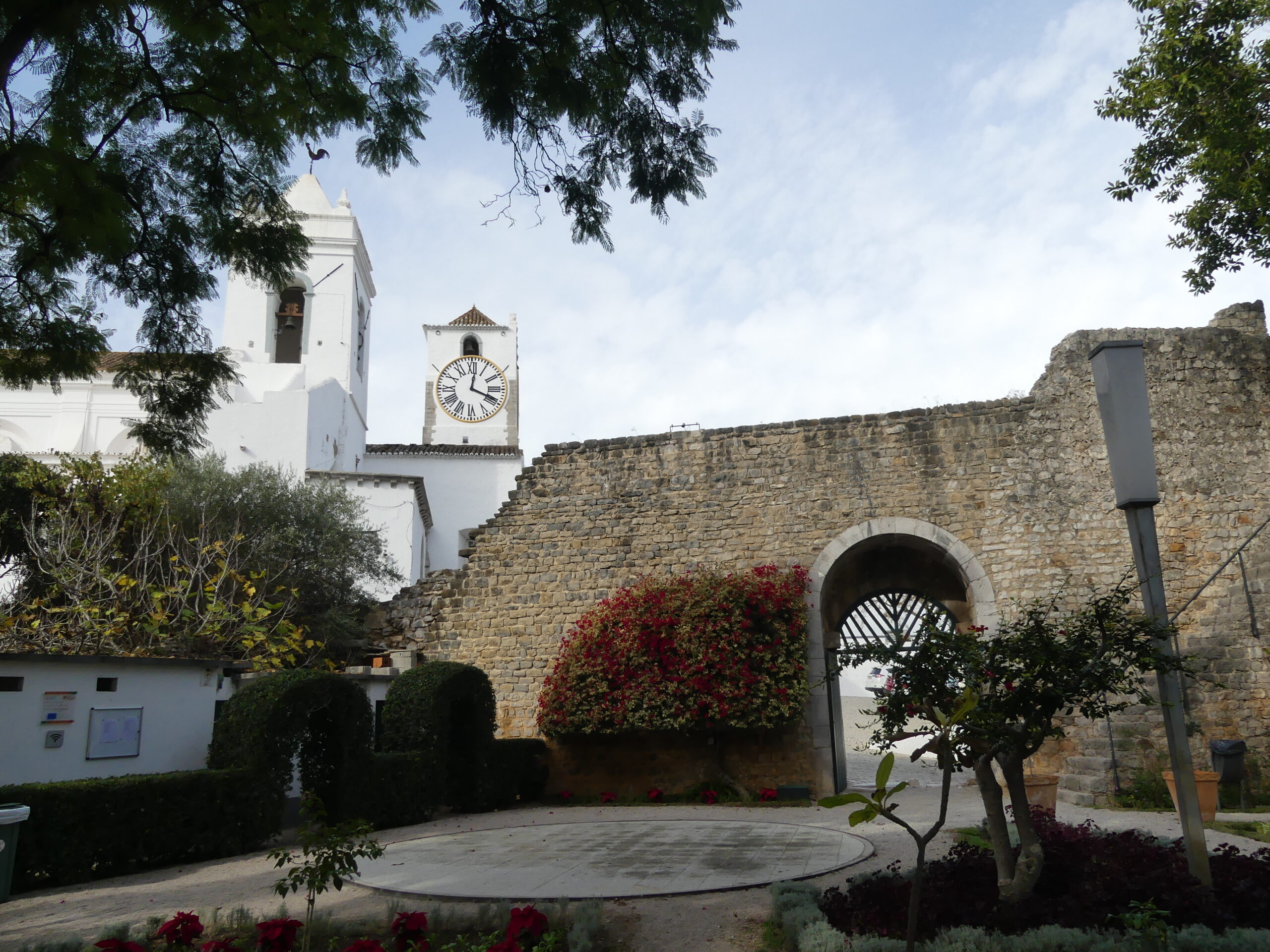
On a sloping street, an unusual baroque doorway is flanked by more typical doors, each of which has a knocker in the shape of a hand, a feature found throughout Tavira.
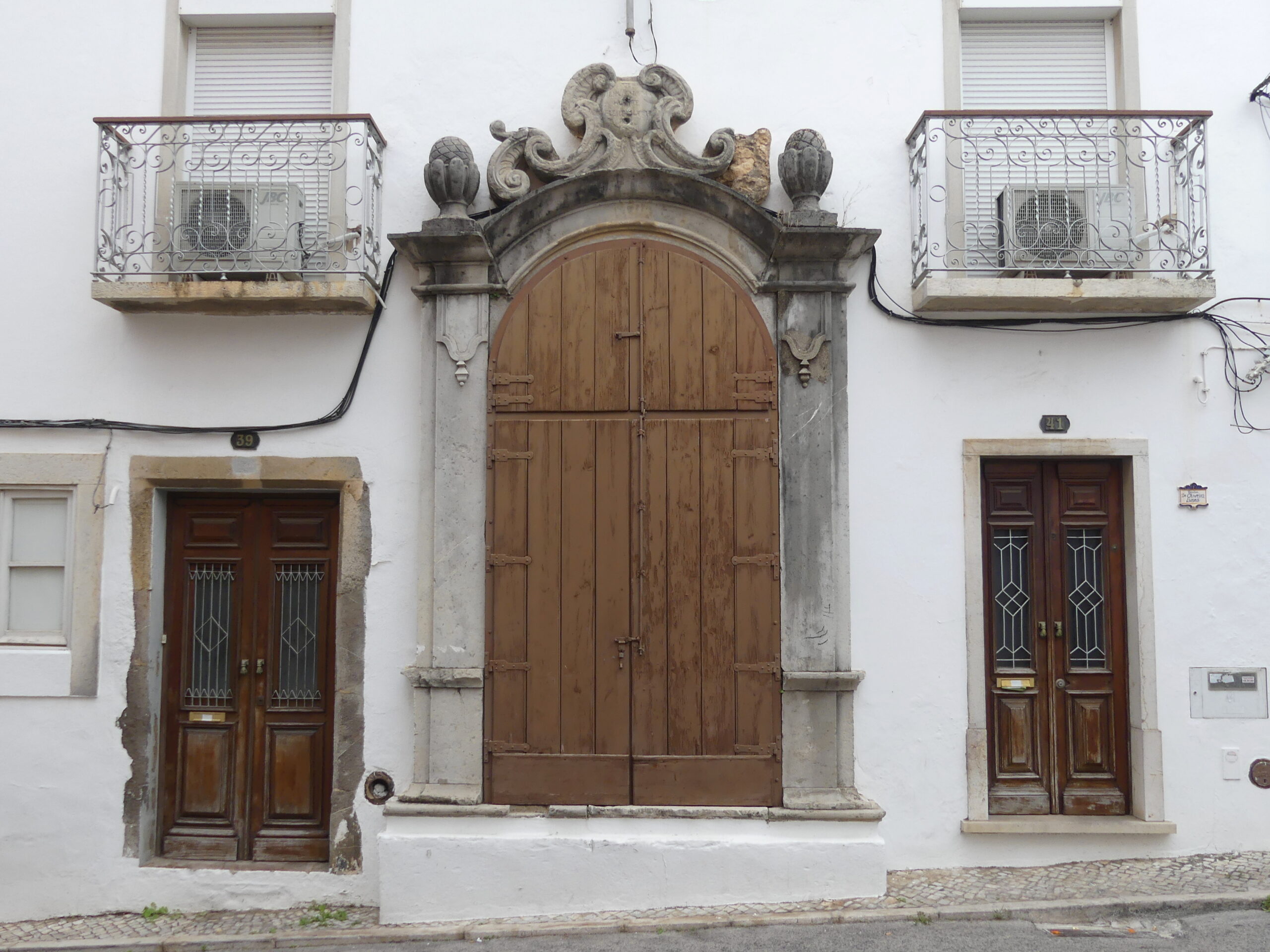
Tavira’s old town had been completely ringed by a defensive wall, much of which is still visible as one walks the streets. Few portals, however, are now in place – though their old names still mark plazas and streets. This one heads to the Republica plaza from the castle hill, with cut-outs to hold the beams that secured the old doors.
Along the riverway
A pleasant walkway and café on the river’s right bank leads to the old Roman (or is it really medieval) bridge, with 18th century buildings on the other side. The pedestrian surface of the bridge is much more contemporary and kind of dull, except for its river views. Continuing past the bridge, one finds a broad park centered around a large gazebo and ending at the late 19th century Mercado building.
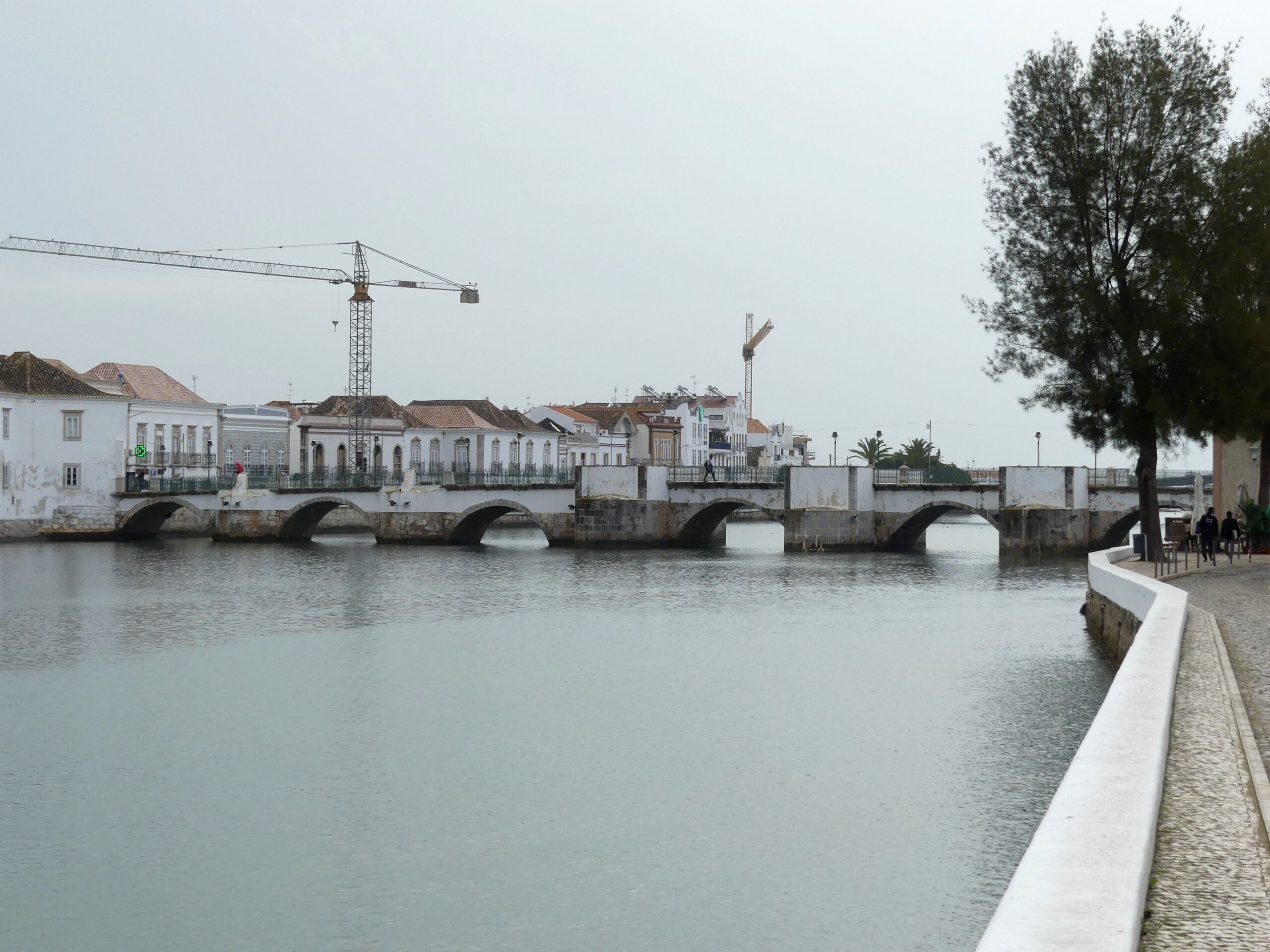
The Algarve towns generally have developed their rivers as amiable places to walk, drink and eat. There are a few of the restaurants on the right (strictly left bank relative to the flow) as we look toward the nearby hills from Tavira’s old Roman bridge.
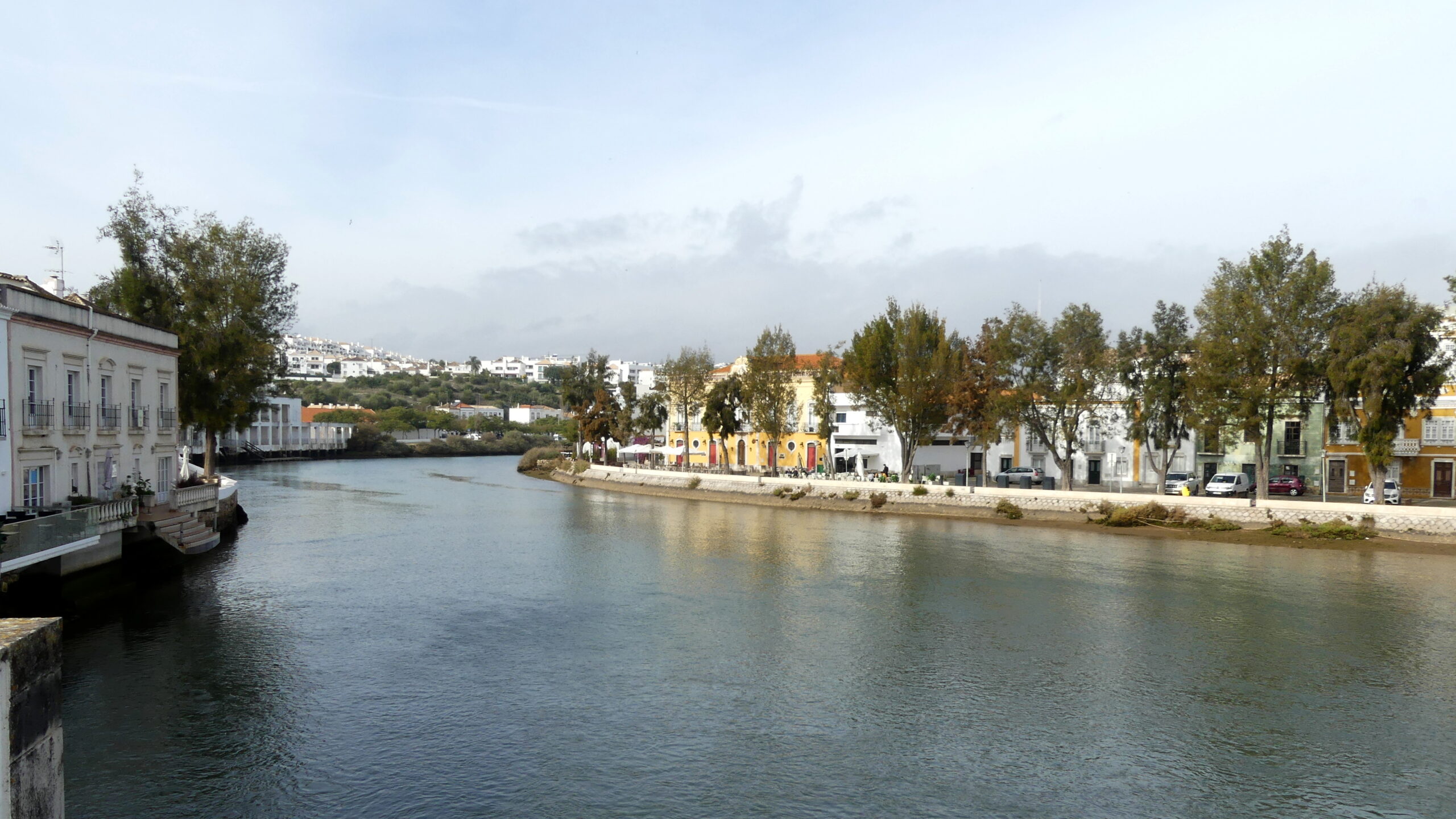
A typical city street on the flatter section north of the river, with charming wrought iron balconies. This one heads to the plaza which is the heart of the town’s restaurant district.
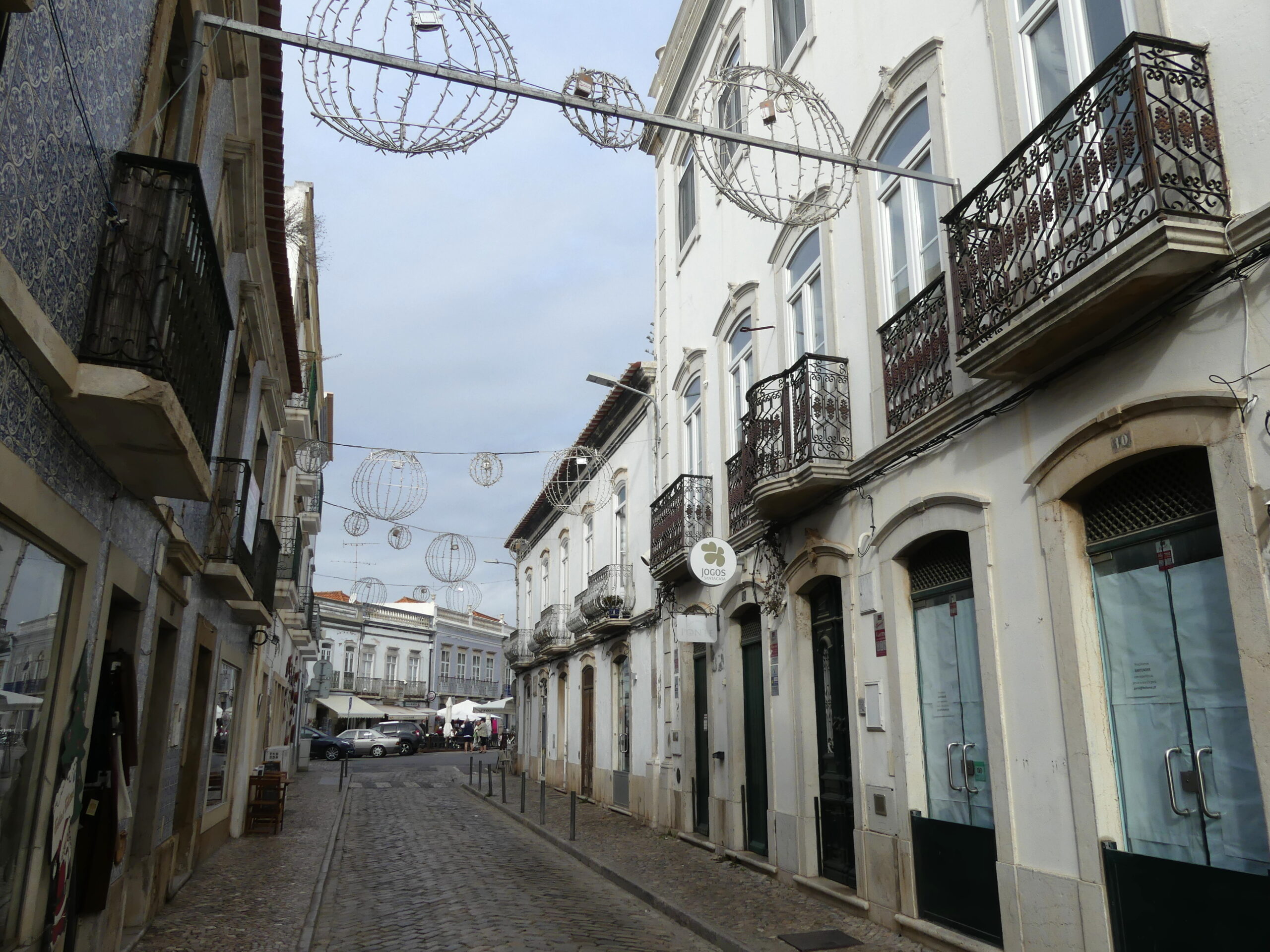
The main plaza of Tavira, Republica, as the grand tree lit up and people scattered to avoid the next rainstorm.
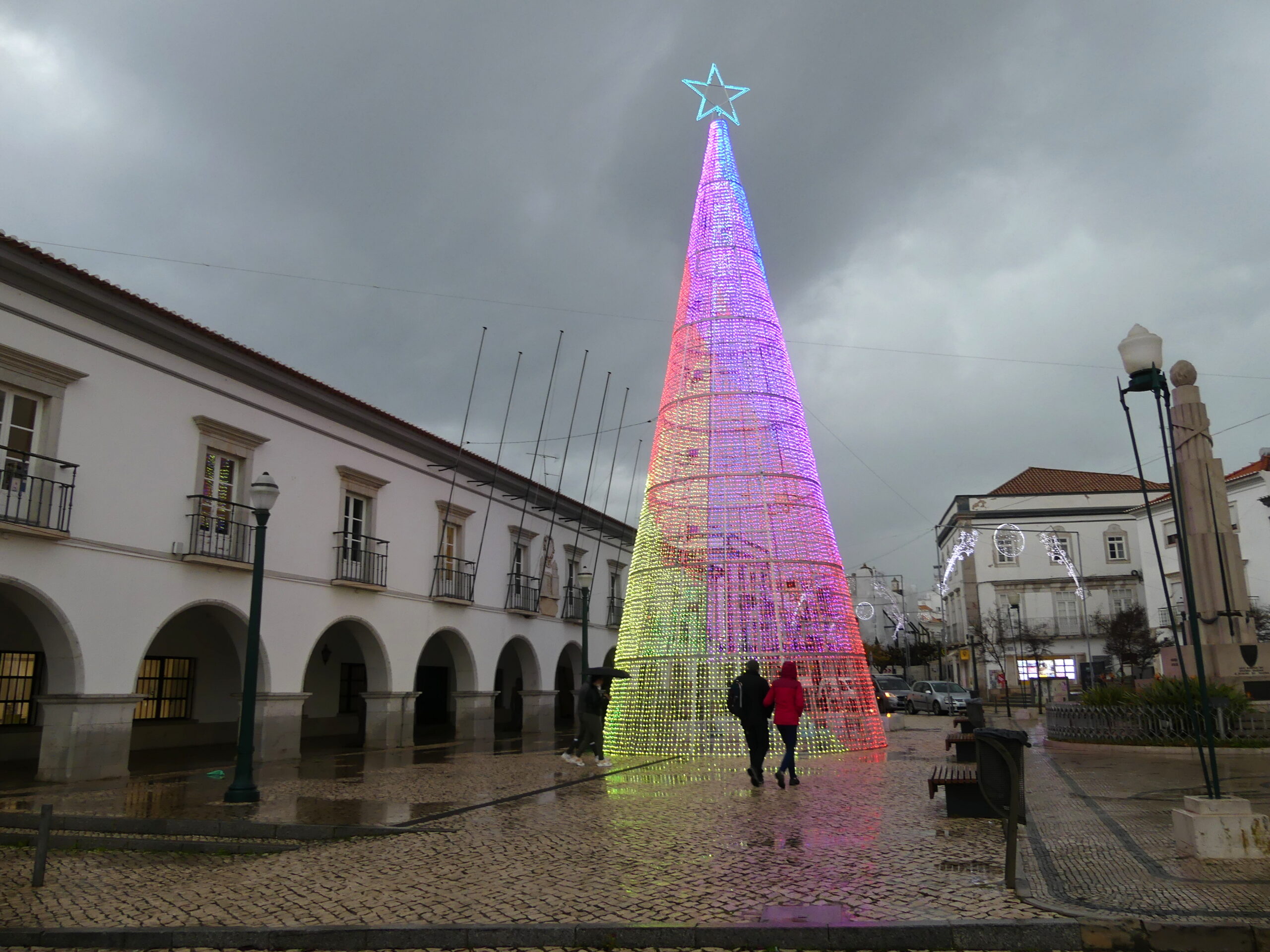
Tavira heritage: its three main churches
Most notable to us among the cultural resources were three diverse churches, nearly tucked into each other on the high hill of the old fort – two 13th century ones rebuilt after the infamous 1755 earthquake, and a 16th century one renovated during the same period. In their development, none of these had the resources of a big city, but their leaders used what means they had to inspire their people in religion and moral acts.
The Main Church of Santiago, the patron saint of the knights that retook Tavira from the Moors, nearly apologizes in its welcoming placard for the plainness of its exterior and interior. The most brilliant parts within survived from the earthquake or seemed moved from other churches. But we loved this multi-tiered wedding cake of an altar enhanced by its elegant framing.
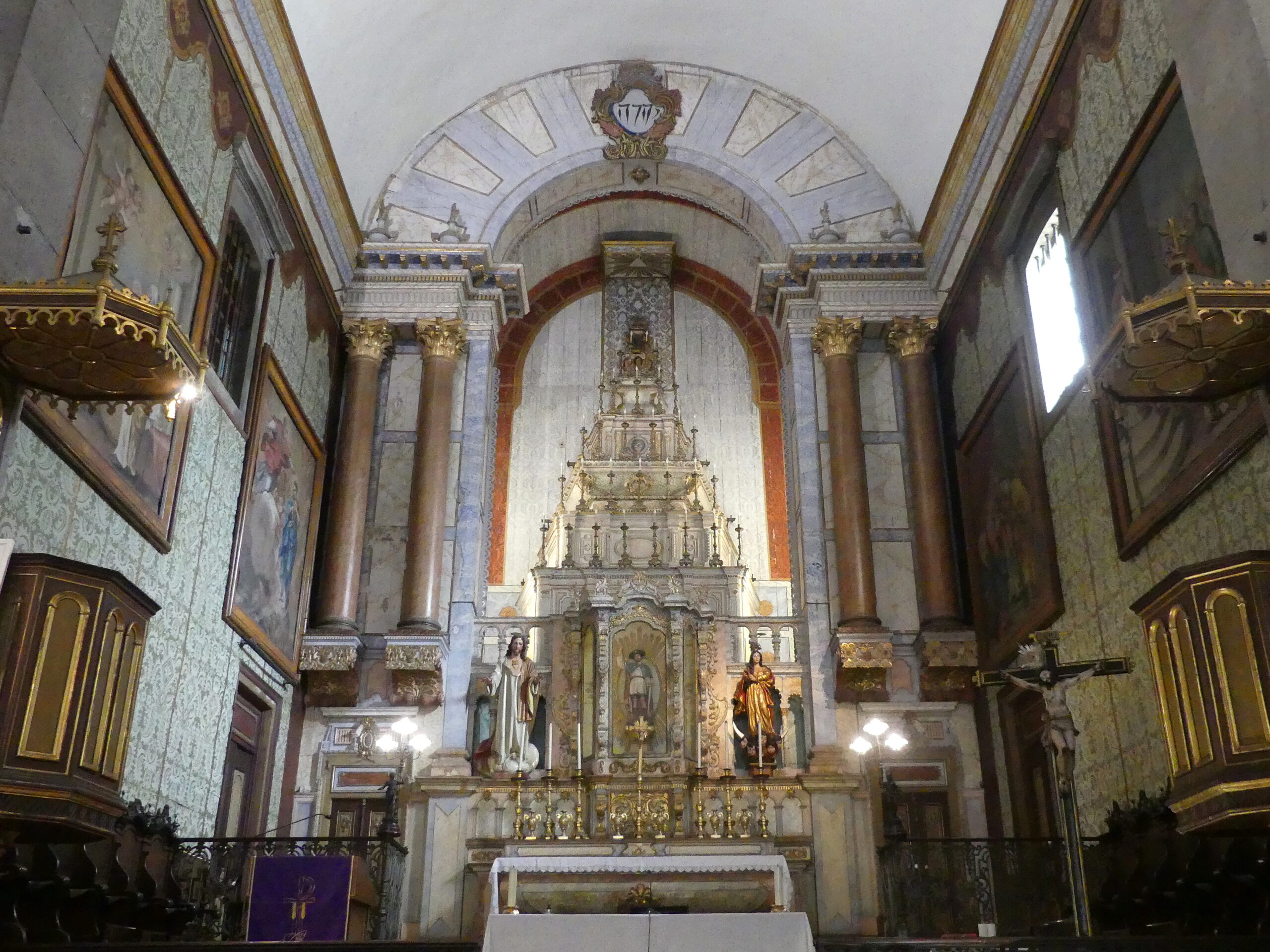
A very attractive retablo from the 18th century rebuilding of Santiago church, featuring Nossa Senhora-a-Franca
A Gothic portal in Santiago secures the largely Renaissance Chapel of the Most Holy and its lovely vaulted ceiling. The four narrow portraits also date from the late Renaissance. We had a little trouble with the iconography defining each, but the cast includes Sts. Peter and John the Baptist, plus two saints held dear by the Portuguese, Sts. Blaise and Vincent.
Atop the stair ascending to the high point of Tavira, gleams this stately neoclassical façade of Santa Maria do Castelo – a match to the neoclassical interior. The church was also founded originally in the 13th century by the Order of Santiago, but rehabilitated after the major damage of the 1755 earthquake. The eclectic portal, as well as the interior, also sports Manueline Renaissance and Gothic features.
The completely redone Santa Maria do Castelo offers a broad open space and ample side chapels on the left only, in a spare but charming neoclassical 18th century style. The altar is one of the few examples of trompe l’oeil technique in the Algarve. With its handsome wood carved chairs drawn up to long tables, this space could pass for the inside of a library.
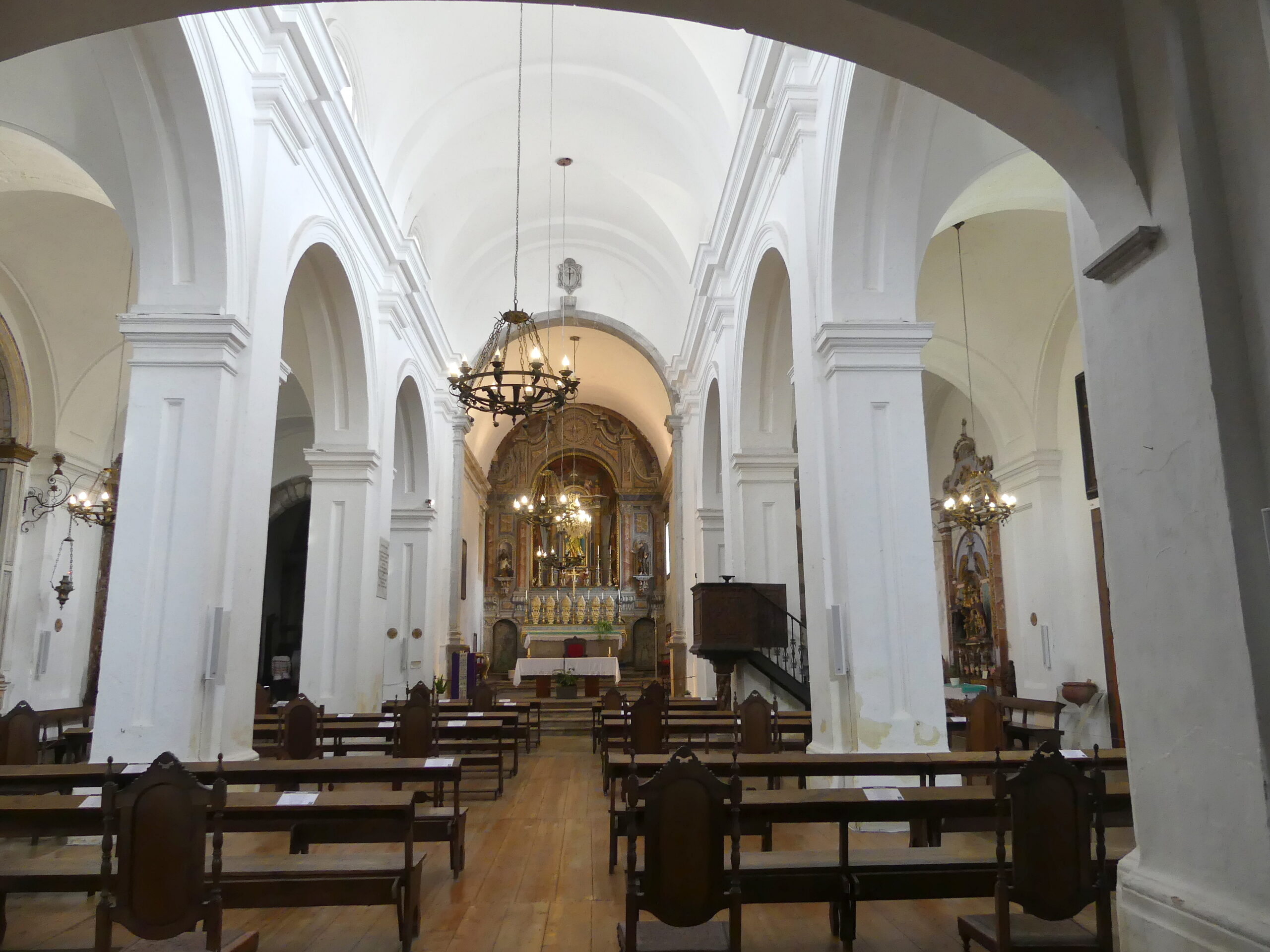
A 15th century crucifixion in radiant alabaster was commissioned from Nottingham, England, survived the earthquake, and was later moved to the museum of Santa Maria do Castelo. The figures of Jesus, along with Mary and John the Evangelist, seem crudely cut, but the gestures are vividly expressive.
Two colorful 16th century Nativity scenes in the Santa Maria museum. What interested us was the mashup of then archaic styles (Spanish Renaissance and Flemish Gothic) and the unusual features of the figures, who seem Moorish in origin. On the left panel, two diminutive angels join in adoring the child, as does a shepherd just outside to the left and the cattle just outside to the right. Behind the shepherd, another angel delivers the good news. On the right panel, we find the same building, with a slightly shifted perspective. It shows Jesus enjoying his Christmas gifts from the Magi.
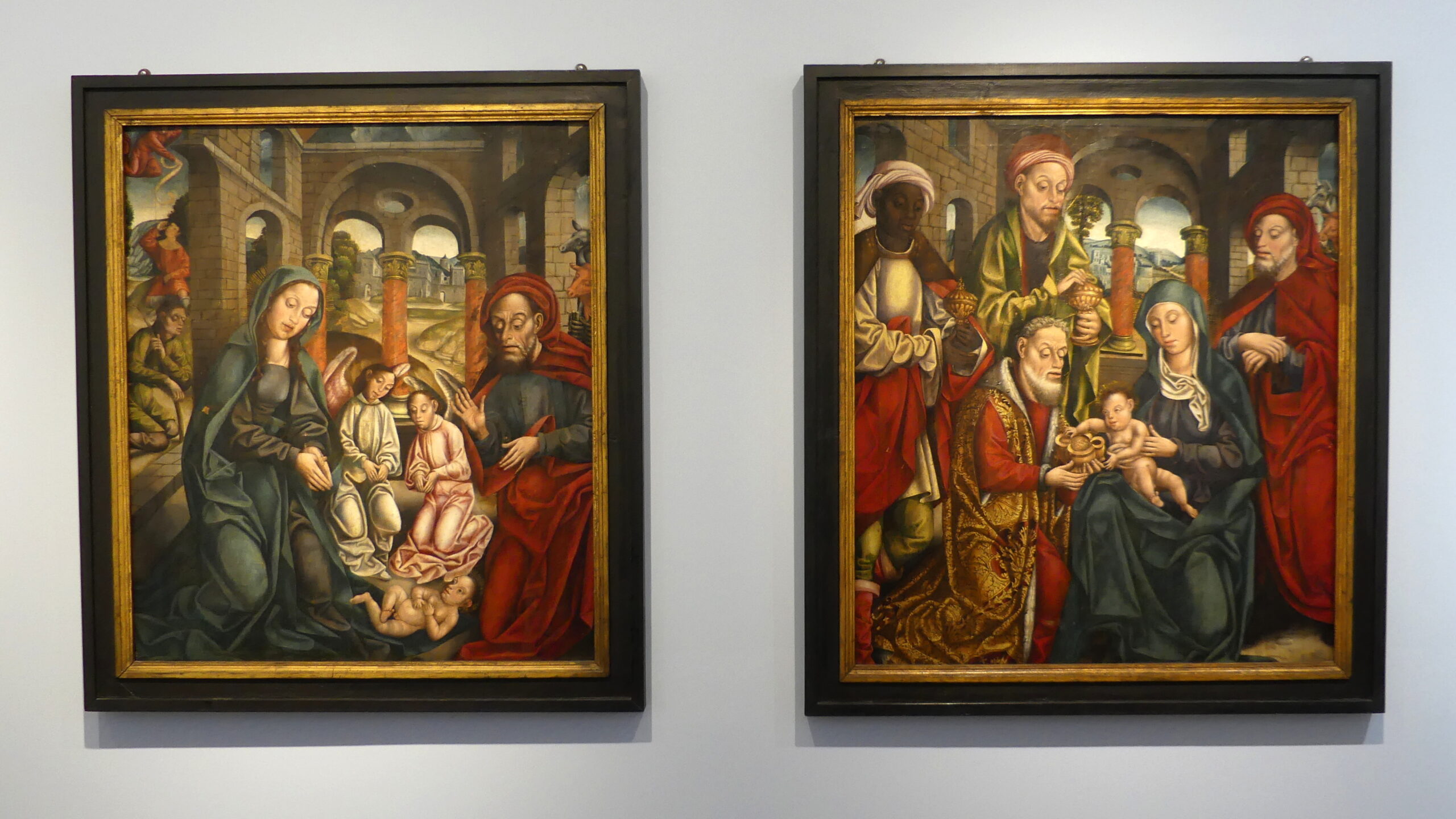
The 16th century portal of the Church of the Misericordia is mainly neoclassical, but with whimsical Gothic touches all around: demons, birds, human figures (including several playing violins), griffons, angels, etc. You can find them by zooming in. At the top of the arch, one angel is pumping iron, perhaps to hold the arch together for another 500 years.
The more somber figures above the arch came a few years later, with the apt Mother of Mercy enthroned and heralded angelically in the center, flanked by Peter and Paul.
To us, this was perhaps the most interesting, and aesthetically the finest of the three, still avowedly 16th century Renaissance as the arches and columns show. The altar and side retablos were updated during the 18th century, along with the extensive tile decoration. From the beginning, the church was the religious center for the Misericordia society, a sisterhood dedicated to charitable acts.
Each of the panels in tile illustrates one of the 14 spiritual or corporal works to which the women pledged, including comfort to those who suffer, dressing the naked, tending the sick, and giving good advice.
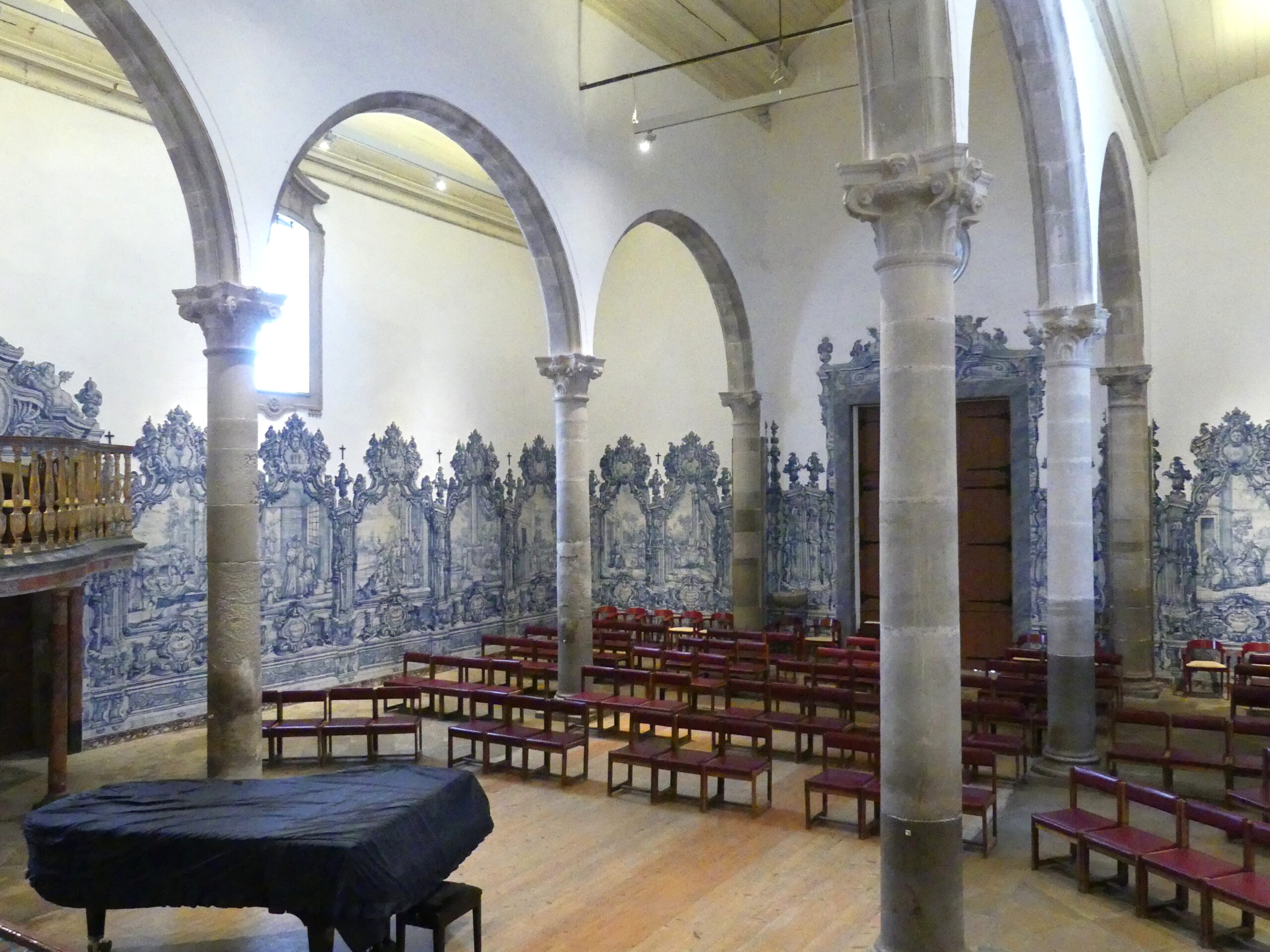
The three naves of the neoclassical interior of Misericordia church and an inviting staircase make a dramatic setting for the impossibly elaborate Baroque altar (whose central detail was in an earlier photo). The tiled scenes also included in an earlier photo (behind and to our sides) show all the virtues practiced by the Misericordia sisterhood.
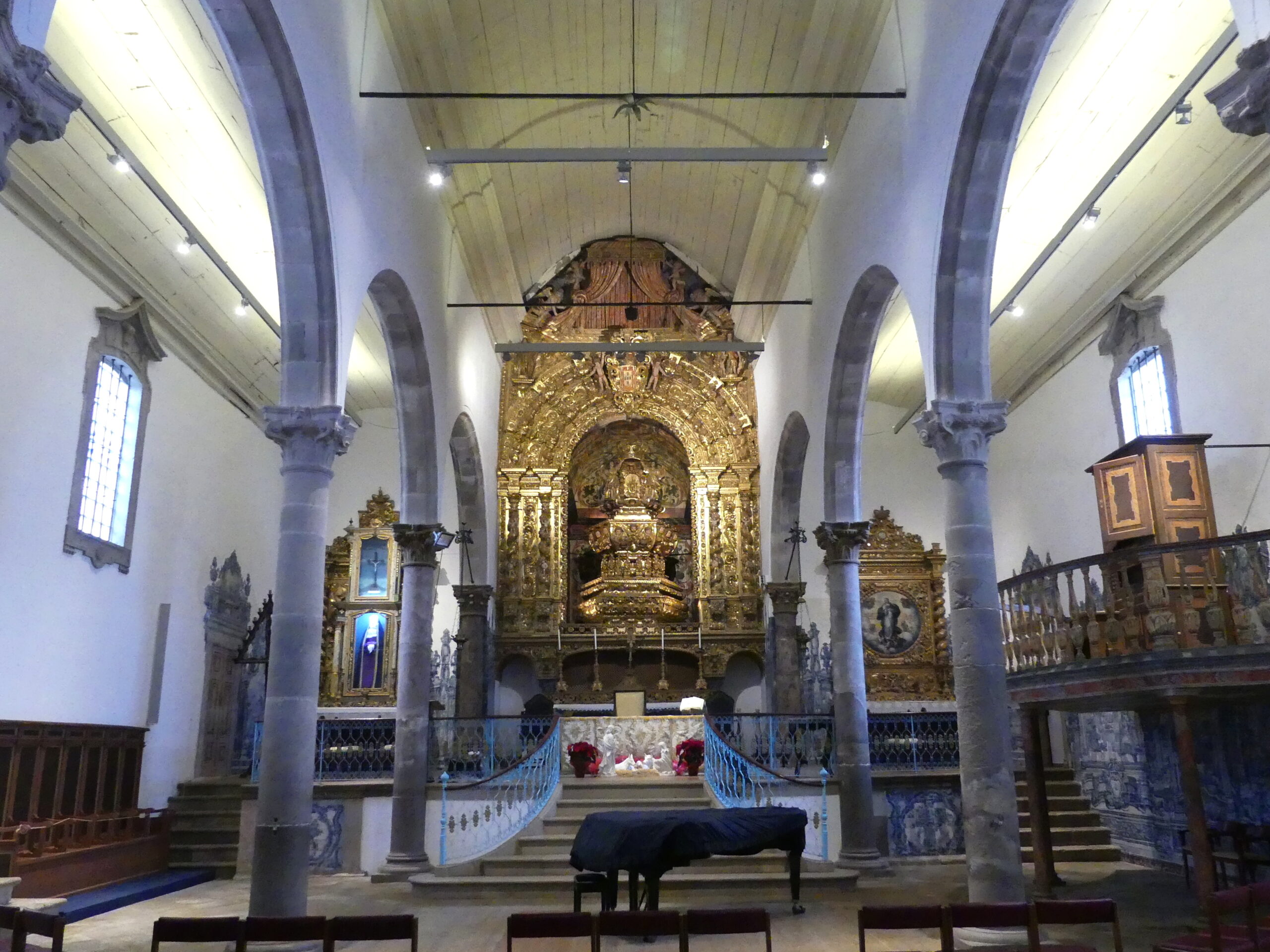
A detail from the exquisite and richly decorated Baroque altarpiece at Misericordia, made of polychrome painted wood
Two of those 14 Misericordia virtues as depicted in the tiled panes: left, be a consultant (Give good spiritual advice); right, raise them right (Teach virtues to the ignorant).Notice how elaborate and highly adorned architectural features frame the virtues.
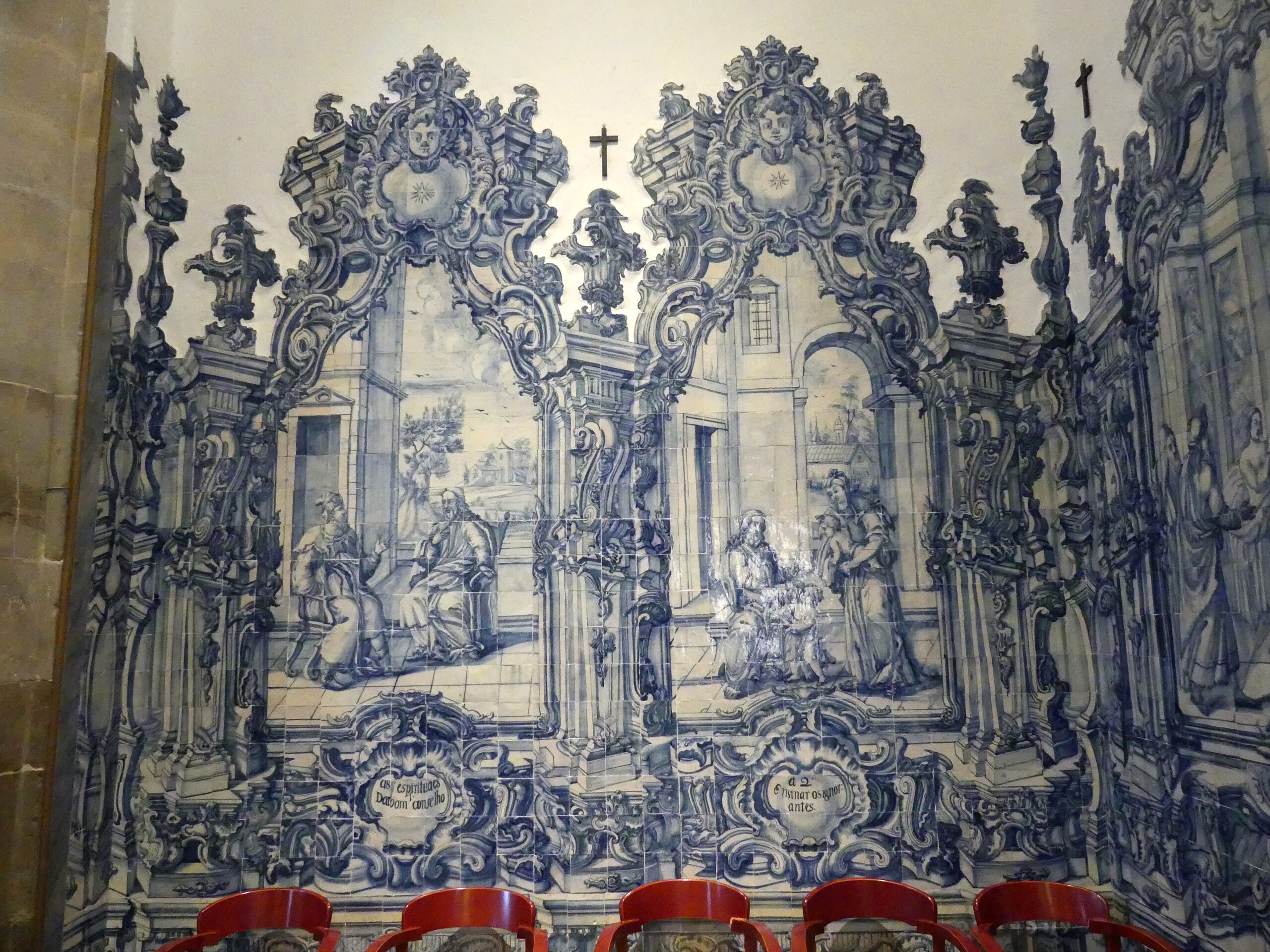
Tavira’s Islamic roots
The Moors ruled Tavira, along with much of Portugal and Spain, for 500 years until the middle of the 13th century. Trade with nearby Morocco and fishing made Tavira economically strong as a port. And the town is fortunate to have unearthed impressive remains from that time – as demonstrated in its Nucleo Islamico museum.
During reconstruction of Tavira’s central plaza near the river in the 1990s, diggers found the old walls of the Moorish castle, as well as 800 year old artefacts. The museum was built around what remained of these walls, including this impressive foundation of huge stones.
Sadly, throughout the country, most of the structures the Moorish rulers built have been destroyed or effaced for other uses since their day. But their influence can be seen in the tiled rooftops and whitewashed stucco houses, as well as on the language. The Algarve – like many place names and items – derives from Al-garb (meaning the west).
The prize of the museum collection is this fanciful celebratory bowl in honor of an 11th century wedding. The bowl itself is sparsely decorated, but the added clay pieces are delightful. The central three figures facing us on horseback consist of a man carrying a log or cannon (left), a woman, and a warrior ready for battle (right). To the left of that group are two figures playing instruments, one a tambourine and the other a square drum of stretched leather (adufe). To the right of the central three figures is another warrior on foot. Continuing to the right, and just visible, is a cute little turtle, which might represent wisdom. Next is an elaborate tower which acted as a water spout for the vase. In the foreground, settled down as in a manger scene, are four domesticated animals considered edible in the Koran – a bull, camel, goat and sheep.
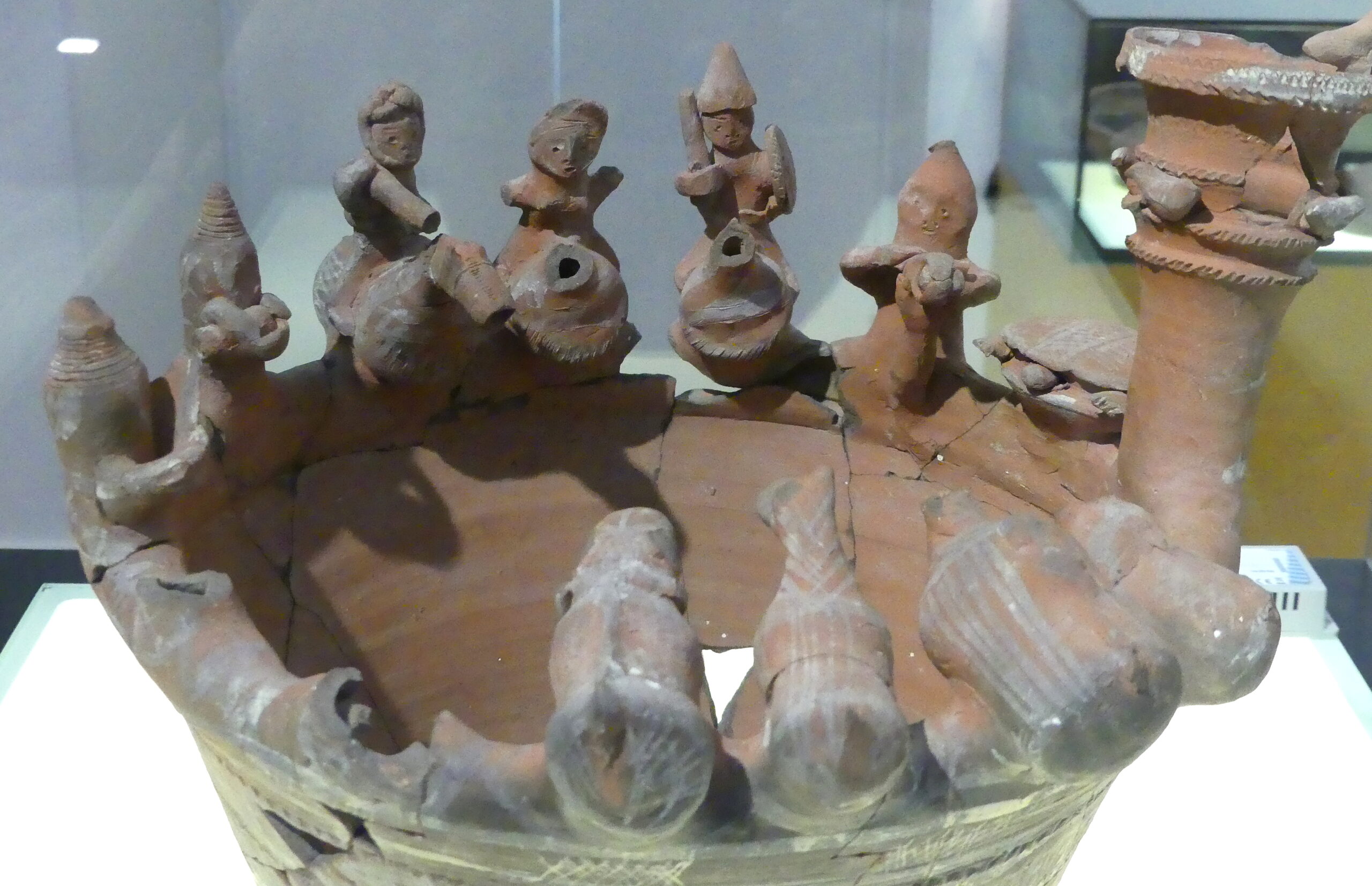
The face of a crazy cat – enlivened by the simple linking of spirals – adorns this water canteen from the 11th century.
This partial octagonal washing basin (12th to 13th century) incorporates very recognizable architectural features found in Moorish buildings.
This simple but appealingly decorated flower vase in the museum dates from the 11th century.
A sculptural fragment in the Nucleo Islamico museum from the 12th to 13th century demonstrates a sophisticated artistry.
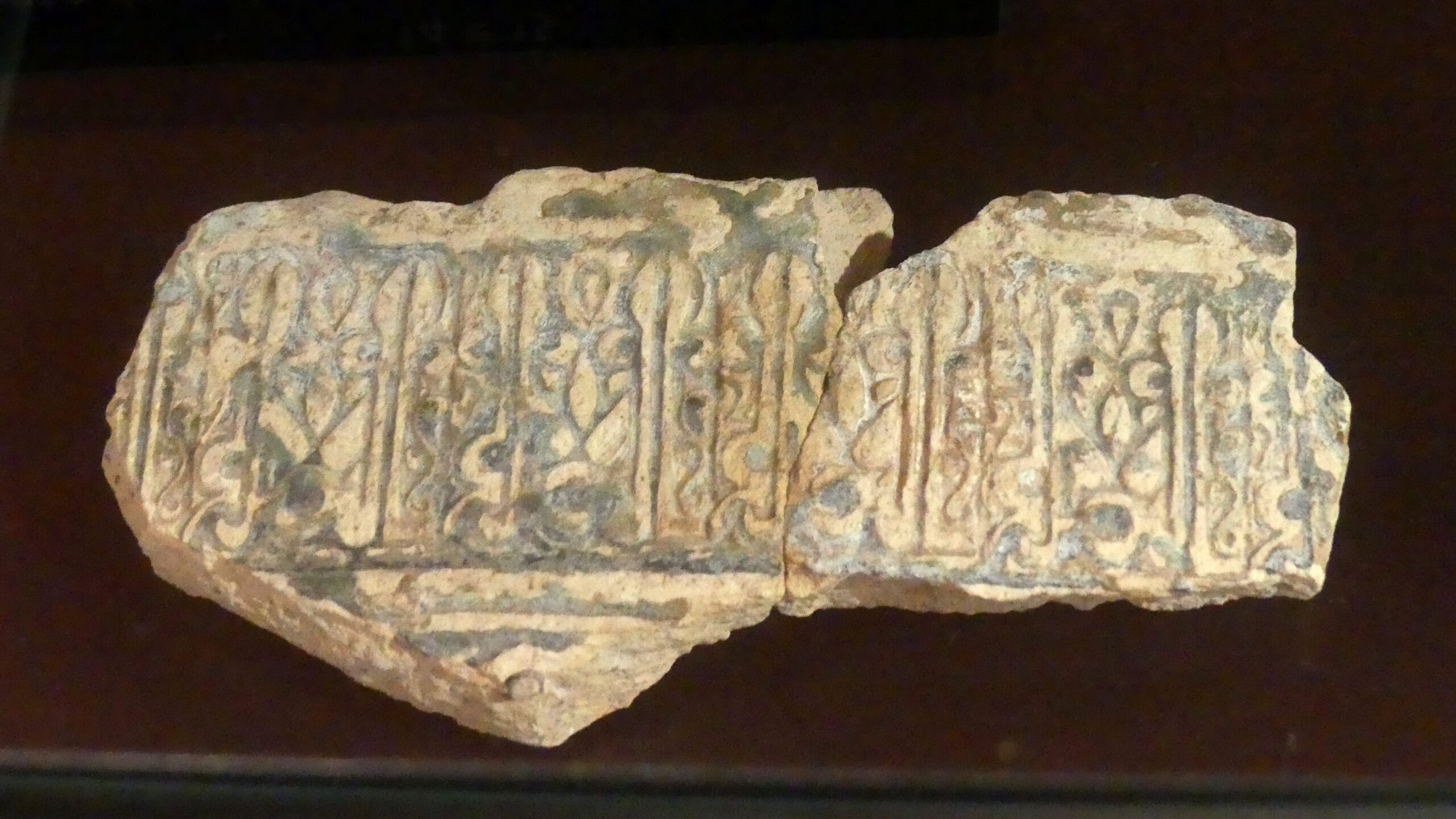
The Moorish rulers were ousted from Tavira in 1242 when tensions erupted into a bloody conflict. The Moorish residents who remained there occupied their own quarter, Mouraria, below the old castle. Later, on that site, Christian leaders built the Convent of Graça. Most recently, the convent was repurposed as a pousada, a top-tier hotel whose bargain rates attracted us during the week before Christmas. The reconstruction unearthed the foundations of 13 Moorish houses from the 13th and 14th centuries.
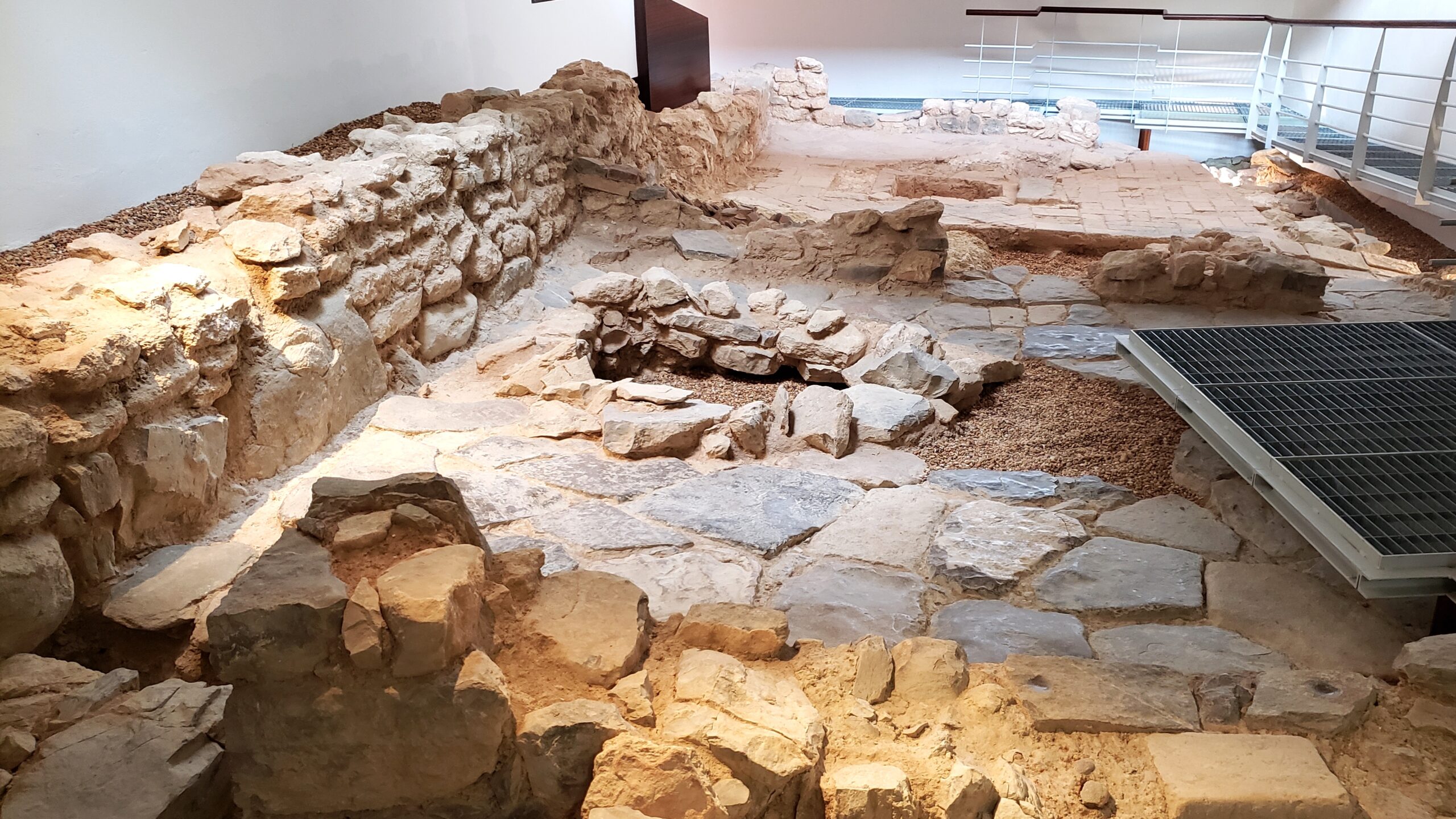
As the photo shows, parts of two of them can be visited beneath the hotel (near the swimming pool), both of which still show original floor tiling. The houses had “modern” water systems for capturing rainwater and funneling wastewater to septic tanks below. And a remnant of the tiled roof is just visible at the left of the dividing wall that cuts across the middle.
A beautiful jar from Granada dating from the 14th – 15th century remains on display below the pousada.
————————
With so much to see and feel, we were not displeased the rainy conditions steered us to them and gave us such virtues.


